#alhambra high
Text

Granada, Octubre 2023
#snapshot#street#street photography#granada#spain#landscape#urban landscape#cityscape#mountain#alhambra#trees#palm trees#high contrast#monochrome#black and white#b&w
53 notes
·
View notes
Video
759 Golden Spike train 29 by Lloyd Rinehart
Via Flickr:
NKP 759 and the Golden Spike train passing the tower protecting the crossing of the Nickel Plate and Illinois Central in Alhambra, IL, on May 15, 1969.
#golden spike centennial limited#nyc&stl 759#nickel plate road 759#hico#high iron company#nyc&stl#nickel plate road#1969#trains#passenger train#history#alhambra#illinois
9 notes
·
View notes
Text
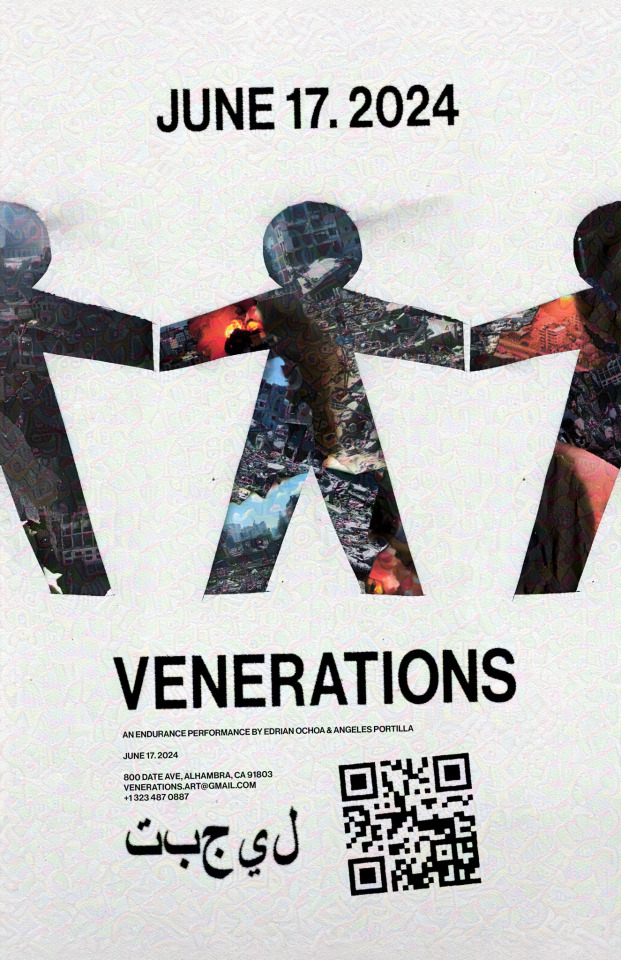


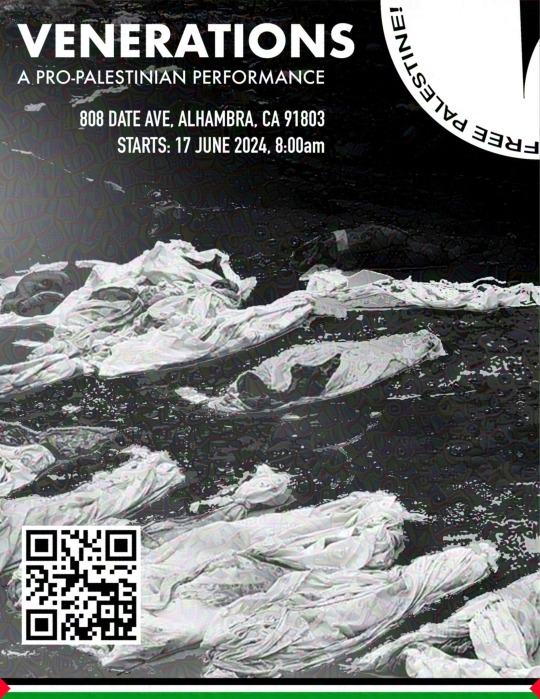
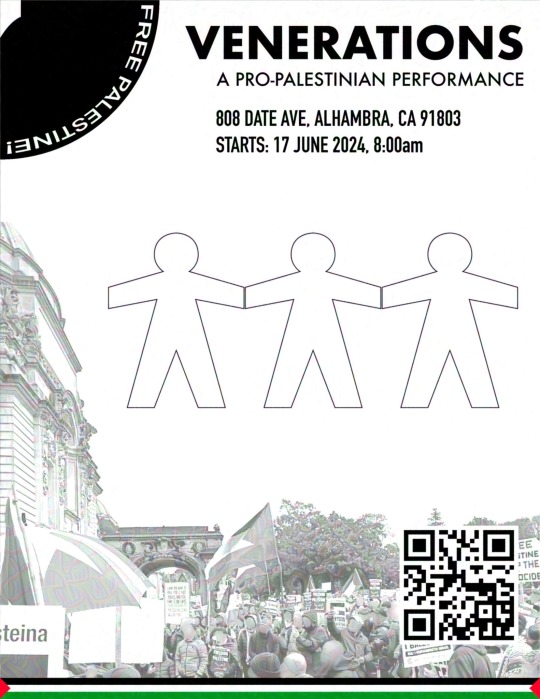
Here’s a bit of a departure from my usual art posting but I’d like to get the word out about my dear friend Edrian and his friend Angeles’s endurance performance and hunger strike for a free Palestine in Los Angeles starting today, June 17th. (More info on Edrian’s Instagram and at venerations.cargo.site)
Edrian will begin cutting out paper dolls and ribbons to reach 35,647 of each, reflecting the reported death toll of Palestinians killed by Israel’s genocide in Gaza since Oct. 7th. He will not move from the venue until he is done and do nothing aside from cutting with few exceptions made for his own physical and economic survival. In addition to that and to represent a microcosm of the suffering in Gaza and Palestine, he will be on HUNGER STRIKE until he finishes. It’s an impossible task to do alone before starving so audience participation is essential. I’m spreading the word to ask for support through participation!
You can participate in a number of ways (more detailed instructions here):
Spread the word. Word of mouth and social media sharing are crucial as this performance is being promoted pretty exclusively via word of mouth.
Donate money to Palestinian aid funds! Certain high donation amounts can help Edrian continue his endurance performance by allowing him to engage in life-giving activities like showering or socializing with a loved one, and reaching the 100k total goal allows him to end his hunger strike.
If you live in and around Los Angeles, visit the venue (800 Date Ave, Alhambra, CA 91803) There you can help him cut and show your support. ***The performance is on the second floor of the venue and there is no elevator so it is not accessible except by stairs :(
If you don’t live near LA, you can cut paper dolls and mail them to the venue address to count towards the total. (printable templates here) This is what I will be doing. It’s easy to do with any spare time you’re not using your hands. I recommend mailing them in small batches if possible to get them in on time and reduce the risk of losing mail. I also recommend including info about the count of paper dolls in each parcel (for example include a note telling the total number of paper dolls) Every small amount counts!
If you are an Art Center College of Design student or alumni, sign the petition to pressure Art Center to divest from Israel! Art Center has refused to host Edrian and Angeles for their performance, torn down their posters promoting it, and in general refused to take a stance against Israel’s genocide. As artists and human beings we must resist genocide and refuse to support institutions that side against the people.
He is also live-streaming his performance and documenting progress if you would like to show support just by being present.
If you’ve never participated in a political performance before now’s a great chance, any little bit counts! I appreciate any time or effort you take to read this, support my friends, and work towards a free Palestine! ♥️🇵🇸
#venerations#free palestine#ik I don’t really talk much or connect with people on social media ^_^; but I appreciate if despite that you support me and my friends! ♥️#please seriously consider participating you can do it for just the cost of postage#also if you’re an ACCD student or an art student in LA it would be really cool of you to show up ♥️#I’m friends with Edrian from taking classes at the LA Animation guild back in the day…and then we found out we went to the same school#and were in the same department too. he’s always been thoughtful brave and radical so it’s really cool of him to do this!#we’d been discussing it for a long time so I’m happy he’s able to get it off the ground now. I hope people consider supporting!#Angeles is Edrian’s friend from ACCD. If Edrian becomes physically incapable of continuing she will continue the performance after him
527 notes
·
View notes
Text

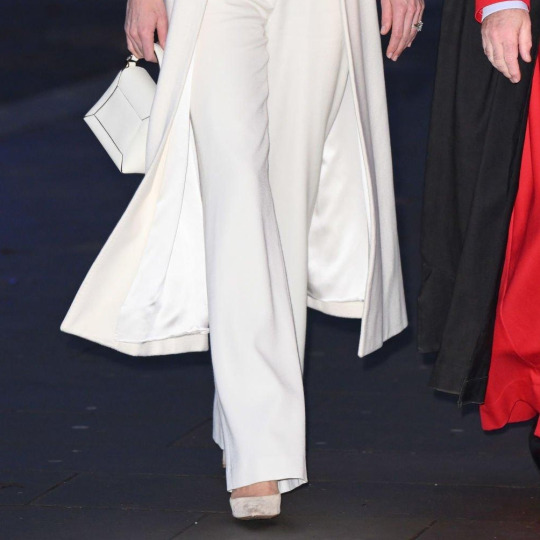
CATHERINE'S STYLE FILES - 2023
8 DECEMBER 2023 || The Princess of Wales hosted the Together At Christmas Carol Service at Westminster Abbey in London.
Catherine opted for -
↬ Bespoke Long Coat in 'White' by Chris Kerr
↬ Cashmere Knit Jumper in 'Off-White' by Kiltane
↬ High Waisted Straight Trousers in 'Ivory' by Holland Cooper × Victoria
↬ 'Magic Alhambra' Dangling earrings with 2 Motifs by Van Cleef & Arplels
↬ 'Mozaic Nano' Handbag in 'Vanilla' by Strathberry
↬ 'Gianvito 105' Pumps in 'Bisque Suede' by Gianvito Rossi
#british royal family#royalty#royal#british royals#kate middleton#royals#duchess of cambridge#brf#british royalty#princess of wales#the princess of wales#princess catherine#8122023#TogetherAtChristmas23#royal fashion#fashion#gianvito rossi.#holland cooper.#victoria magrath.#holland cooper x victoria.#maya alhambra earrings.#magic alhambra suite.#magic alhambra suite#van cleef and arpels.#van cleef & arpels.#kiltane.#chris kerr.#strathberry.#catherines style files#style files 2023
66 notes
·
View notes
Text

Edna Mae Harris (September 29, 1914 – September 15, 1997), sometimes credited as Edna May Harris was an American actress and singer. Harris was one of the first African–American film actress of the late 1930s and early 1940s, appearing in films featuring mostly African–American casts.
Born in Harlem, Harris parents were Sam, a boxer and customs inspector; Her mother Mary Harris (née Walker) worked as a maid. Harris' family is noted as one of the first families to have migrated to Harlem. Settling near the Lafayette Theater, Harris was convinced into pursuing a career in show business by Ethel Waters and Maud Russell who were frequent visitors to her family home. After being coached on her singing and dancing by Waters and Russell, Harris began performing in the Theater Owners Booking Association (TOBA). An African-American vaudeville circuit, Harris performed with TOBA from 1929 until 1933.
Harris attended Wadleigh High School (later known as Wadleigh High School for Girls) in Manhattan. During the summer after her sophomore year of high school, Harris worked at the Alhambra Theater doing dramatic sketches with a stock company. During this period, Harris received excellent training in diction and stage delivery through her association with veteran performers. Harris was also an excellent swimmer in high school, and in 1928 she entered the New York Daily News' Swimming Meet and won a championship.
Harris first real Hollywood break came when she landed a part in The Green Pastures (1936), portraying Zeba, starring with Eddie 'Rochester' Anderson. Harris was a leading lady in Spirit of Youth (1938), the story of the rise of boxer Joe Thomas, which paralleled the life of Joe Louis. Harris also had leading roles in Oscar Micheaux films, Lying Lips (1939), and The Notorious Elinor Lee (1940). Her film credits also include such Hollywood films as Bullets or Ballots (1936), Private Number (1936), and Garden of Allah (1936), and the independent film Paradise in Harlem in 1939. Between picture commitments she toured with Noble Sissle's Orchestra as a featured vocalist along with Lena Horne and Billy Banks. In 1942, she played fourteen weeks at the old Elks' Rendezvous as the mistress of ceremonies and announced a weekly radio show over station WMCA in New York City. She also did character dialect parts on many broadcasts for the Columbia Workshop Program. Edna Mae Harris got to tell her story in her later years in the documentary, Midnight Ramble (1994), about independently produced black films.
Harris was married twice and had no children. Her first marriage was to Edward Randolph from 1933 until 1938, then to Harlem nightclub owner Walter Anderson from 1951 until his death in 1983. Harris dated boxer Joe Louis sometime during 1939 and 1940. Harris dated Robert Paquin, who co-starred with her in the Lying Lips from 1941 until 1942. Harris died of a heart attack on September 15, 1997 at the age of 82.
#black literature#black tumblr#black excellence#black community#civil rights#black girl magic#blackexcellence365#beautiful#strong black woman
30 notes
·
View notes
Text

Pam and Jim visit Spain and Morocco, 1971
Jim Morrison arrived in Paris on March 11, 1971, where Pam was waiting for him. Pam forced him to visit the American Hospital in Neully. There he had a quick medical examination, including X-rays. He was told that his lungs were in bad shape because of cigarette smoking. He was advised to stop smoking and drinking immediately and to go to a warmer place so he could get better.
Jim Morrison took advantage of the doctor's advice to fulfil his old dreams. He would visit Madrid, Granada and Tangier.
On April 10, 1971, Jim rented a Peugeot Sedan. With Pam, he took the road south. They spent the first night in Toulouse. Jim wanted to enjoy the architecture of the pink-coloured buildings in the French city. The next day they crossed the border with Spain through Andorra and slept in Barcelona.
One day later, on April 14, they arrived in Madrid and visited El Prado Museum. Jim had written poems and had described on several occasions the sensations that an incredible triptych painting by Hieronymus Bosch, El Bosco, provoked in him. Pam told the anecdote that Morrison spent more than an hour, as if hypnotized, in front of "The Garden of Earthly Delights", filmed by Pam herself on the Super-8 camera that Jim had brought from Los Angeles.
Jim and Pam arrived in Granada on April 16. They wanted to see the rooms where Washington Irving had written his "Tales of the Alhambra", a book that was always a dream for the Doors singer. He liked mysteries and the dazzling Nasrid world of the 15th century. The neighbours say that he went from the city centre to the monument for three days straight and that, sitting on one of the benches in the Generalife gardens, he wrote a beautiful poem that, apparently, has disappeared. Nor is it easy to find the Super-8 film that he and Pam recorded there, in front of the Patio de los Leones. In any case, the Arab enchantment did not disappoint a young man who was accustomed to LSD and hallucinogenic experimentation.
Bill (billr2375 on youtube) recalls:
Jim and Pam followed our High School Spanish Club on a visit to LA ALHAMBRA-GRANADA, Museum in Spain. We didn't figure it out at the time but later realized they were the "two American hippies" listening in on our English version of the Museum Tour. Can read about his visit to that museum on that date in a book about Jim. They were very cool--would nod to us, but kept their distance as they followed us on the Tour. He had a beard at that time, she was beautiful. They were clearly in love with each other. Giggling and holding hands and enjoying that we didn't recognize them. (source)
Morrison's visit to the Alhambra was immortalised in the famous Super-8 film. Jim appears in front of the lions, the famous lions in the Alhambra Courtyard. In the film, the singer can be seen against the backdrop of the fountain, with his arms clasped to his chest and a smile. He slowly approaches the camera lens. Pam told months later that this film was the one Jim watched on the night of his death, while listening to the song 'The End' by the Doors.
Jim and Pam spent four days exploring some of the corners of a Granada that was, more than ever, an exotic place for two inhabitants of hippie California. Some people from Granada said that they stayed at the Alhambra Palace. Others, that they actually spent the night at home of some Australian colleagues. Rafael Cuéllar was one of those who recounted that visit and defended this last hypothesis. He also told an anecdote that is not without its macabre character:
In a place called La Zíngara, Morrison asked them to play a song by the already deceased Janis Joplin. “You are drinking with number three,” he said to all those who approached him, alluding not only to Joplin’s death, but also to that of Jimi Hendrix. The fatal premonition would end up coming true.
After four days, the couple headed to Gibraltar. There, they had to 'let go' of their Peugeot, because the insurance did not cover their stay in Morocco. When they arrived in Tangier, they stayed at the famous Minzeh hotel, where Paul Bowles sat every afternoon. But they had been invited by Paul and Talitha Getty, in their winter palace.
Pam also remembers that at the old market, Jim bought a French version of Paul Bowles' 'The Sheltering Sky' from the Colonnes bookstore on the Pasteur avenue in Tangier. Jim was obsessed with the relationship between Paul Bowles and his wife Jane.
Jim and Pam flew to Marrakech, which was all the rage because of the hit song by Crosby, Stills and Nash. There, they stayed at the Ville Taylor, the mansion that the Count of Breuteuil and his mother owned on the outskirts of the city. On May 3, 1971, just two months before his death, Jim and Pam flew from Marrakech to Casablanca and from there to Paris. Heading to his end. Jim Morrison had shaved one night when he bathed in the moonlight at the Marrakech hotel, the only one with a swimming pool in those days.
SOURCES
Josa y sus cuentos
Vanitatis
NOTE:
Just after their Spanish/Moroccan trip/holiday, Pam and Jim travelled to Corsica and stayed there for 10 days, the exact date is unknown, but here you have more information about their trip.
#Pam Courson#Pamela Courson#Jim Morrison#1971 Pam#Super 8#Super 8 films#home movies#model#muse#boutique owner#fashion designer#baby sitter#editor
17 notes
·
View notes
Text
Kazu Kibuishi nearly died while making ‘Amulet.’ Two decades later, he’s completed it. – Orange County Register (ocregister.com)
A passage from the article:
But in the decade since his recovery, Kibuishi says he still feels the effects.
“It changed my life, for sure. That’s part of the reason why I can’t write as fast as I used to. I can definitely draw just as quickly; that’s just motor skill. But writing is really what takes the most time,” he says, adding his memory has been affected – sometimes he’d finish a page only to realize he’d already drawn it before. “There are certain obstacles and hurdles I have to get over. I don’t want to use it as an excuse but … I have set a standard with my former self that is very hard for this brain to match.”
Kibuishi’s memory came up when I mention an earlier meeting we’d had. Years ago, not long after he’d recovered, I’d reached out to tell him how much my family enjoyed his books and Kibuishi had invited us to visit his Bolt City Productions studio in Alhambra. While a memorable event for us, Kibuishi says he can’t remember much from that period.
“That time in my life, I just have to accept that I was a bit of an amnesiac. There’s like a crater in my memory,” he says. “I don’t know if I’ll ever fully recover from it, but I manage well, I think, despite all of that.”
That explains why Amulet turned out the way it did. I deeply regret the harsher points of my criticisms, but my points about flaws of the series still stand.
On one thing, I presumed that his injury may have played a factor, something that severe especially in the brain is not something you would 100% recover from. On the other hand, I thought it is pretty wrong to speculate or assume further about Kazu’s medical history because that’s ultimately his business to divulge or not.
So I assumed it was arrogance. I assumed that since he’s secured a good number of loyal readers, he’s just putting whatever because a.) he’s done with Amulet, and b.) people would read his books either way, so why bother with quality? Which is not only extremely bad faith of me, but also deeply insulting to Kazu as an artist. To which I am regretful, and I do apologize. He really just can’t remember. The Amulet we started with isn’t the Amulet we ended with.
That also explains his process. He’s made around 1000 draft pages for book 9, then pick and discard what he wanted to keep and honestly, I’m pretty sure someone with a direction for their story wouldn’t have such ramblings that would take 1000 pages (I myself who also draws a lot wouldn’t make that high of a number), the process overall was just yonkers. But for someone with a spotty memory… That’s probably the best method he could come up with.
But in all honesty, reading this article gave me an overwhelming sense of peace. I could live with Kazu’s reasons if it was because he’s done with Amulet, or if it was because of executive meddling, or if it was for medical reasons. Mostly because these are all problems that can be fixed. A better project, a better employer, a better work schedule, better accommodations. I still think the writing is awful and declined badly, but I’m more relieved that it isn’t because Kazu no longer cares or values his work. Ultimately, he genuinely did the best he could.
40 notes
·
View notes
Text
How do you come home to a place that no longer exists?
I got lost in the sauce of Heinrix nostalgia and ended up worldbuilding a whole planet.

The moment Heinrix stepped on Dargonus, he had been struck by a sense of nostalgia so powerful it would have brought a lesser man to tears.
Okay, apparently someone does wonder what's going through my head with this fic. For me and for them, here we go.
From Talavera, With Love is momma's most self-indulgent fic yet. And I have Heinrix's Starseeker longfic nostalgia to thank for it. What does it mean to want to go home to a place that you can never go back to? Not just physically, but the idea that that home may have changed and is no longer your home because that home exists in the past. A.k.a the diaspora whiplash of reverse culture shock and Nick Joaquin's lamentations in the Woman with Two Navels.
Sometime between June - August, I got completely overtaken by Noli Me Tangere and El Filibusterismo brainworms while obsessively playing and taking screenshots of WH 40k Rogue Trader. In Noli Me Tangere, a young man returns from Europe only to discover that his father is dead after his political enemies conspire to imprison him for challenging the abuses of Dominican friars (Hello Rogue Trader surprise ascension, hello Kunrad oust plot, hello Ecclesiarchy drama with Incendia Chorda) and he spends the entirety of the novel trying to do an Iconoclast playthrough in a game that demands he play Dogmatic. In the end, he is labeled a heretic and has to escape. Fast forward to El Filibusterismo, the opening chapter is on a fucking ship that is used to show the division between the Upper Decks (Upper class society) and the Lower Decks (Voidborn, hello!).
Which is how ya girl ended up here.
The Love Letters to the Philippines
The Maw and the Embocadero: The Maw is equated with the Strait of San Bernardino, one of the most treacherous passages of the Manila-Acapulco galleon route.
Folk Catholicism and variances on the Imperial Cult: Calligos Winterscale's lucky charm, the Talaveran (Guisorn III) cult to Sta. Rosalina de la Soledad who is associated with sea-faring because of Nuestra Señora de la Soledad de Porta Vaga, the Lady of the Manila-Acapulco galleon trade who is the patroness of Cavite, a region that used to be a Spanish military base and the shipyard that produced most of the galleons for this route.
The cult of St. Drusus v. Sta. Rosalina: The age old rivalry between the Dominicans and Jesuits in Manila. The conflict between local "Filipino" priests (at a time when Filipino really meant insulare, a Spaniard born in the colonies. Rana and Heinrix, if we want a real 1:1, would count as insulare) and peninsular priests after the opening of the Suez Canal. More below.
Geography: The high sierras of Talavera are a nod to the Alhambra (This city is a bride whose husband is the hill), The Sierra Madre of Mexico, and the Sierra Madre of Luzon, the island home to the Tagalogs. A lot of the place names in FTWL's Dargonus are chosen based on whether they exist in Spain, Mexico, and the Philippines.
The Temerian phoenix: Initially a silly reference to Ibong Adarna's mystical bird of Piedras Platas. By chapter 8, equated with Calligos Winterscale. A wild beautiful bird that is forced to become a feral beast for bloodsports. Also, just the irony in cockfighting being one of the surviving pieces of native cultures in a lot of colonized places even though it's a sport that kills.
A Mixed Bag
What does it mean to be one of ours?: Tagalogs keep it simple. If you are born there and raised there, you're one of theirs. If you assimilate fully, you can belong too. Rana genuinely thinks Kunrad should be Rogue Trader, despite him stepping away because of the Life Changing Commorragh and Epitaph fieldtrip, because he is Dargonus native born and raised and she writes Abelard off for the same reason. None of the conflicts in FTWL are linked to race (that's for the Drukhari and Aeldari), but to cultural assimilation. Nick Joaquin's Question of Heroes is a window to a point in time when being part of a people moved from "we look like each other" to "we share the same culture". A lot of Filipino ethnic groups apply this logic quite consistently. When in Rome, do as the Romans do and if you do not do as the Romans do, do not call yourself a Roman. Gaining your local "punto"/accent is a "Wow, you finally assimilated!" between the many Tagalog regions, just to name an example. Tagalogs can also be... quite xenophobic for the same reasons. The whole "Sandara Park is more Filipino than Vanessa Hudgens" national agreement after the latter was made a tourism ambassador.
The Hate Comments for the Philippines
Language: Talavera as a rediscovered Imperial world develops its own language. Heinrix's derogatory attitude to Dargonian creole (brought over by the first Lady von Valancius) is a nod to Filipino native hispanophone attitudes towards the Ermitense, Caviteno, and Zamboangueno creoles.
Calligos' sideye at Dargonian culture: Calligos is a native of the Koronus Expanse and so is Incendia... but so are the natives of the von Valancius protectorate. That said, they have a varyingly hostile relationship with Dargonus, a nod to how "indigenous" in the Philippines doesn't mean "native", it means you come from a culture that has never been Catholicized or hispanized.
Rana's side eye at Incendia's insistence on adopting a more familiar and widespread cult and culture: "When Manila sneezes, the Philippines catches cold." or so Joaquin writes. Rana's resistance to Incendia is a combination of personal trauma and a mash-up of the rest of the Philippines' resentment of "Imperial Manila" (The Tagalog, catholic, hispanized culturally and politically centered ethnic group), the complicated relationship between Folk Catholicism and the Vatican.
The Dinner Party: Incendia argues that Sta. Rosalina's cult and Dargonian culture are too foreign and not well-known to subjects outside of Dargonus. Rana argues that St. Drusus and Calixian culture (Incendia's camp) are just as foreign to the Koronus Expanse as she is. A nod to the demonization of hispanic creole cultures in the Philippines in the wake of 70s... after the Philippines wholeheartedly embraced Americanization. This isn't even about colonization, this is about loss of identity. There are a ton of unused "Filipino" words that came out of the nationalist movements of the late 1900s that were meant to replace loan words that were naturally adopted into local languages. The removal of Spanish from the curriculum while English is retained. The portrayals of colonization in history books as "bad colonizer and good colonizer" (as if there is such a thing LMAO) by comparing Spain to America, with the argument that the former was far far worse and could never be "ours". Never mind, of course, that after 300 years of colonization and the Filipino panuelo birthing the Manton de Manila (a Chinese creation based on the former and spread world-wide through the galleon routes coming out of Manila), the creolized cultures of the Philippines are a conversation between native culture and Spanish/Mexican culture, or that a lot of the Virgins of the Philippines absorbed ancient worship practices for older gods, or that the friars --- so often the villains of this story --- are responsible for the preservation of the Baybayin script and local languages (Why does the Philippines not speak Spanish? Aside from resistance to Old World disease, the friars who were wary of Muslim influence creeping up from the south in Mindanao just LEARNED the local languages and went crazy because that's what happens when you're fresh out of the Reconquista and your new colony, which is litered with sultanates, is discovered in the mid 1500s).
So, how do you come home to a place that no longer exists? FTWL Heinrix refuses to embrace change much like the "nationalists" who insist on creating an exoticized orientalism lite pastiche of Filipino cultures (much to the annoyance of actual IPs), clinging to a vision of distant Talavera (Guisorn III) that only exists for him. He mourns it while Rana celebrates a rebirth of it on Dargonus where Talaveran culture has creolized with the local Koronus Expanse culture. For Calligos, who has never had a real home or family, coming home is adopting a home and he embraces the cultures of the Rykad system in their entirety.
#posts from the trenches#lorraine's logs#from talavera#filipino culture#noli me tangere#el filibusterismo#von valancius#heinrix van calox#ultimately#i just wanted a telenovela but try telling my brainworms to reel it in#momma said go ham cram in everything you love#which apparently means telenovela tropes like love triangles#and whatever the fuck this is#wow was i really carrying that in my traveler's heart the wholetime#crazy
9 notes
·
View notes
Text
How They Like to Cuddle Part 2
Rip Van Winkle:

She personally likes any position that she can hug you in. She is very affectionate towards you and tends to get a little bored after sitting around. You normally cuddle at the end of a very long day and have her as the little spoon, she loves the feeling of her favourite person holding her after a long day! She'll complain and ask to move but will pout if you let her go. On the other hand, if she is in the mood for cuddles she will not let you go at all. It will start at any time in the day, she'll simply seal you away and make you cuddle with her all day or until she's had enough. When she wants them the two of you assume the positions of the spoon in which you are the little spoon and she is big.
Jan Valentine:

Jan is also a very hyper man but loves having you by his side, he especially loves your touch. He typically keeps you on his lap and has his hands firmly planted on your ass. On his off day when he doesn't feel too good or he's pissed off because Luke scolded him for having fun, he'll come to you and the two of you will cuddle. He likes to be on his knees hugging your waist while he lays his head against your chest and listens to your heartbeat.
Luke Valentine:

It's hard to get him to settle down with you and cuddle because he takes his job more seriously than his brother does. The times when you do get to cuddle he can't seem to get enough, he steps off his high horse and begs you to cuddle him or really to just spend time with him. He'll open his arms wide and kiss your neck softly as you stay in this warm embrace, it takes a while before he gets in bed and most times it won't happen. Since he's a vampire he works all day and night.
The Captain:

The Captain is nothing but a gentle giant when it comes to you, because of his superhuman abilities he is too scared to actually let himself hold you at all. Instead of him holding you, you hold him, and he will slide down low on the bed and rest his face on your chest while that, or if you really insist he will hold you close to him. Your face turned to look at him, hands gently placed against his chest as he plays with your hair.
The Major:

The Major initially thinks that it is a waste of time, why would he cuddle his beloved when he could be planning another war or waging against multiple countries? When you finally manage to get him to stop and drag him to your private chambers for some relaxation, he finds that this is the best thing he can do with his time...besides waging war. He gets many devious ideas when he is laying with you so he will occasionally come and lay with you for a few hours while he tries to get over his creative block. You sit in his lap and rest your head against his chest, he will occasionally give you kisses if you stay still or give him good advice.
Schrodinger:

This scornful energetic kitty loves cuddling with you, he definitely prefers you over The Major. Besides, you are much more entertaining than the kitty's boss. He likes to lay on you, his head on your chest, body splayed out on top of you. When you are on the move in a place he can't just lay on top of you, he will rest his head on your lap silently requesting that you let him between his ears.
Tubalcain Alhambra:

He is one arrogant mother fucker so he never takes any small position, point, blank period. He holds you and even carries you around nearly everywhere you or he goes. Not much to say when it comes to him, he is the big spoon, he is at the bottom of the snuggle pile, and he is the one holding you close. This is more because he needs to keep you safe, he loves you too much to let you get hurt.
The Doctor:
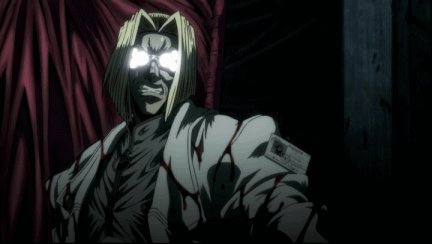
I am genuinely surprised you kept him out of his work long enough for him to consider the thought, let alone to actually lay down with you. You're his first so he is a little awkward when it comes to doing anything so domestic like cuddling. He is very basic, he just spoons you and lets you relax in his arms, he feels rather embarrassed when you hold him but he supposes it's a little nice to get away from his work.
Zorin Blitz:

Zorin is the type to pin you down in bed, she'll lay on you or hold you in a tomb-like hug while you lay on your side. She knows exactly what you need at any specific time so she very happily obliges, all she wants is for there to be a smile on your face. She can get a little antsy but if you haven't had enough time with her, she just picks you up and lets you hug her from behind while she carries you around.
Hope Ya liked this! Please send in any requests you have and check out my list of things that I write for!
#zorin blitz#jan valentine#luke valentine#the captain#hellsing#hellsing fanfic#hellsing fanfiction#Schrodinger#headcanon#millenium#luke x reader#jan x reader#fluff#tubaclain#tubalcain alhambra#tubalclain#the dandy man#vampires#cuddles#rip can winkle x reader#alucard x reader#hellsing alucard
195 notes
·
View notes
Text


Granada, Octubre 2023
#snapshot#street#street photography#granada#spain#alhambra#palacio de carlos v#architecture#monument#history#spanish history#high contrast#monochrome#black and white#b&w#canon eos m#canon
20 notes
·
View notes
Text
100 Albums to understand Muse - Part 1 [STYLE Series #004 - Muse (August 2010)]

The members of Muse started as a band in the heyday of Britpop, but their strongest influences were the US alternative scene, as well as the Grebo music scene such as Ned's Atomic Dustbin. Their musical interests broadened, especially Matthew's, as he travelled and met people in different countries, and he dabbled in tango, flamenco and even Italian folk music.
Muse were, of course, greatly influenced by the greats of the rock world, including Queen, but they also greedily embraced classical music such as Chopin and Rachmaninoff.
Here we introduce some of their influences and the artists they were involved with. These are 100 discs for a deeper enjoyment of Muse's world, and you'd be remiss if you didn't listen to them!
Text by Sumi Imai (I), Masataka Oguchi (K), Junya Shimofusa (J), Akiko Mima (M/board selection),
Hisashi Murakami (H), Tomoo Yamaguchi (T), Shiho Yamashita (S)
AC/DC
Back In Black
(1980)
The sixth album from Australia's greatest treasure, AC/DC. The riff of the classic ‘Back in Black’ on this album is one of the first phrases that every boy who picks up a guitar learns. A great rock basic, so to speak. Of course, the [guitar] prince is no exception [to this]. He performed a cover of the song here and there at the Australian festival Big Day Out. -J
ADAM LAMBERT
For Your Entertainment
(2009)
Adam Lambert was born and raised in the US, and his dramatic vocals are a feature of his US TV show ‘American Idol’. His major-label debut featured songwriting contributions from Lady Gaga, Pink, Weezer's Reeves, Darkness' Justin and many other well-known names. Matthew also contributed a song called ‘Soaked’ to the album. -H
ANDRÉS SEGOVIA
The Art Of Segovia
(2002)
Matthew once travelled to Spain to study flamenco guitar, but it was Francisco Talega of ‘Memories of the Alhambra’ fame, born in Spain, who laid the foundations for classical guitar in the 20th century. This is a collection of masterpieces by Andrés Segovia, the master who took up many of Talega's works and popularised the classical guitar. -S
AKSAK MABOUL
Un Peu De L'âme Des Bandits
(1980)
Belgian avant-garde progressive band. The band's diverse style is characterised by the use of piano and strings in tangos, contemporary-style suites and fast-moving punk, all of which make full use of the high skills of the band members. The band's wonderfully chaotic sound, where materialism and realism collide, is too good to be described as ‘only known to those in the know’. -M
Translator's Note: I'll be putting whole albums of the selected albums listed on this article. I'm of the belief that the best way to enjoy an album is to listen to it from start to end, so that we can understand the influences far better. Also, I'm doing this because I want to mess with YouTube's algorithm and leave it very confused on what it's supposed to recommend to me in the near future.
#Muse#The Resistance era#AC/DC#Adam Lambert#Andrés Segovia#Aksak Maboul#my scan#translation#STYLE Series#STYLE Series 004
10 notes
·
View notes
Text


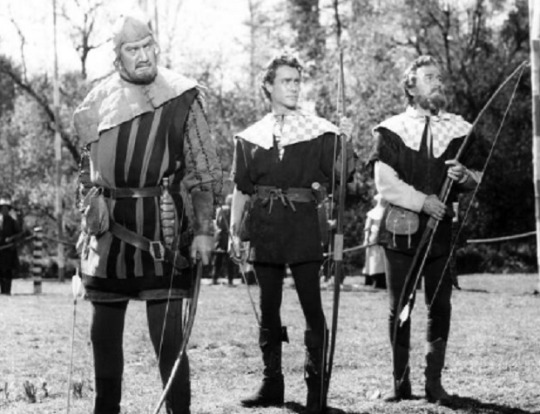
The Scottish actor Archibald Duncan was born in Glasgow on 26th May 1914.
His father was a regimental sergeant major and his mother a postmistress. He was educated at Govan High School and afterwards and worked as a welder in the Glasgow shipyards.
It was at the Citizens Theatre Company that Duncan joined the training ground of many Scottish actors including, Molly Urquart, Duncan Macrae, Gordon Jackson and Eileen Herlie. He then made his Scottish acting debut in Juno and the Paycock, playing all three gunmen, at Glasgow's Alhambra in May 1944.
Duncan went on to star in London's West End with the likes of the great Scottish character actor Alistair Sim and the late George Cole. Film roles started to follow with , Floodtide , The Gorballs Story, The Elusive Pimpernel, Green Grow the Rushes, Henry V, The Lavender Hill Mob, You're Only Young Twice and Walt Disney's The Story Of Robin Hood and his Merrie Men as 'Red Gill' amongst many others. Duncan also teamed up with Richard Todd and James Robertson Justice in Disney’s Rob Roy the Highland Rogue as Dugal Mac Gregor.
One of Duncan's first big TV roles was as Inspector Lestrade in the 1954 series Sherlock Holmes, but perhaps Archibald Duncan is best remembered for his second Robin Hood role, where 6'2" Duncan played Little John alongside Richard Greene in The Adventures of Robin Hood which ran for 143 episodes on ITV here and CBS in the states from 1955 to 1959. I just had a wee look and many of the episodes are on Youtube.
Duncan's portrayal of Little John would be fondly remembered decades later for his combination of strength, skill and humour. It was during the filming this unforgettable series that this Scottish gentle giant proved to be a true hero and managed to prevent a runaway horse from hurtling towards a group of spectators, consisting of mainly children, watching close by. For this brave feat, he was awarded the Queen’s Commendation for Bravery and £1,360 in "damages". But it also resulted in him missing the recording of eleven episodes of Robin Hood. So between times, a replacement was found in fellow Scotsman, Rufus Cruickshank.
Another great Scottish film he appeared in was Ring of Bright Water. Archie Duncan's career in television production carried on with parts in programmes like Z Cars, Hereward the Wake, Orlando, Black Beauty and Bootsie and Snudge.
Sadly in 1978 he suffered a massive stroke which caused paralysis down his right side. Sadly he passed away at Whipps Cross Hospital in Leytonstone, London aged 65 on 24th July 1979.
13 notes
·
View notes
Text

"Exceeded expectations" EXO CHANYEOL's presence shines in "The Frog"
"..he received favorable reviews from viewers. Park Chanyeol appeared in the latter half of the drama wearing round glasses and showed high synchronization with his child actor counterpart, instantly capturing the attention of viewers. He also showed his presence as a scene-stealer by dynamically performing the action scenes of running nonstop with a gun.
The main narration that runs through the entire work is naturally done with his signature baritone voice and accurate diction, and he calmly conveys Koo Giho's emotions mixed with revenge and anger, helping to immerse the audience until the end, receiving good responses.
Park Chanyeol said, "In order to create [an image of] Koo Giho, I asked the director a lot of questions and imagined and thought a lot about Giho's life. I think it's an honor just to be able to work with such a great director, writer, and seniors. It's a work that I've learned a lot from. Every moment of filming was a happy memory, and I'm beyond grateful."
Park Chanyeol, who has been loved by global fans as a member of EXO, is also actively promoting as a solo artist by releasing his first mini-album 'Black Out' on the 28th, and also took on various challenges as an actor in 'Memories of the Alhambra', 'Missing 9', 'Salut d amour', and 'The Box'.
Translation by No Loey No Life.
2 notes
·
View notes
Note
I am Palestinian and there is absolutely no characteristic of Palestinian culture in Dorne or the Martells. Their stans only use racial stereotypes about us & orientalist characterization to justify it and prove that the Dornish are “POC” in order to make them seem oppressed, and are pushing even more racism and orientalism towards MENA populations.
According to them, the Dornish are simultaneously Arab, Desi, Amazigh, Iranians, Turkish, and sometimes, Latinos. North African, West Asian, and South Asian countries are lump together as one monolithic “brown people” entity. 30+ countries with multiple, unique, and diverse cultures and religions, very distinct from each other. The Martells simultaneously celebrate Diwali and goes to Hajj. Why would the Dornish follow Hinduism or Islam ?? They largely follow the Faith of the Seven, the Westerosi Catholic Church.
For their edits, they use pictures of the Alcazar of Seville or the Alhambra, castles located in SPAIN, and fancast drop-dead gorgeous INDIANS actresses like Deepika Padukone, Freida Pinto, Aishwarya Rai as Elia (“a kitchen drab”....) or adult Rhaenys. Or Dev Patel as Young Griff. They keep using the screenshot of GRRM listing Palestine as one of his inspiration for Dorne to justify their headcanons, so why do they keep insisting on using Bollywood movies, Indian actors, Indian monuments, saris, etc ?? The only common points between the Alcazar of Seville/Alhambra and the Taj Mahal are the Islamic architecture and the engraving of Quranic verses.
Disclaimer: EDITED, Long, and Repetitive bc of attempt at clarity and Reminding Readers
Maybe coming from this post (I've gone back and edited it with corrections)?
I think it's because people really want to see PoC representation in their high fantasy literature, which is completely valid. However, yeah, the Dornish aren't Palestinian-coded nor Arab/SouthAsian/etc.-coded...I mean, they mainly worship the Seven, too, the Westerosi polytheistic version of Catholicism. So they can't necessarily be 1-1 like Palestine in terms of culture & ethnicity, even though the ME does have Judaism & Christian peoples. Again, Dorne--as far as was told & shown--mainly worship the Seven. (look to section "B", point #1)
The Point: A singular major, past, centuries-old event of intermarriage before the Targs arrived is not a continuous event. The Dornish are nor and have never been subjected to become a state under the Westerosi crown for there to even be a commencement of racialization as by the would-be conquerors of said situation.
The Rhoynar marrying pre-Rhoynar Dornish peoples happened in a few isolated incidents. Afterward, the people became what they now are and after many decades & centuries,
THEREFORE,
they do not have that "two people" identity anymore. They are just "Dornish".
Their ancestry is always brought up mainly because of their custom of noblewomen being equally as able and seen as worthy to rule as their men, esp the Martells. To compare them to Westerosi farther up.
A)
Doylistically, on the one hand, people could claim that the Dornish could claim PoC-ness or be easily adapted into being played by PoC actors in the real modern sense by who they are descended from -> an Essosi people who had darker skin. Yet the Valyrians and Andals--who themselves come from Essos originally!--are "white" by the 1st being "proto-English with a Catholic religious analog and the 2nd being an ancient Rome-analog"?!
The Dornish are not Rhoynish either just because they are descended from the Rhoynar who--a very long time ago (centuries, before the conquest)--intermarried with Andal-descended lords and presumably smallfolk. Ethnically, they are something else entirely (maybe Andal-Rhoynar but that seems insufficient) their own thing from their unique history.
So, we have "Moor" descendants marrying "white" Christian Spaniards. So, like Spaniards and Italians, they seem the "lesser whites" which still makes N.Euro descent and N.Euro look at Italians, Spaniards, or those in Central EU as "lesser whites". Meaning that they have both Andal and Rhoynish roots with the Rhoynish equal primogeniture and opener-sexuality and little-to-no bastard stigma really defining its difference from those Westerosi further north. Dorne is a state with various skin-colored but seemingly non-racialized people (internally, not how the Andal-FM nor Daeron I characterize Dorne) and the Dornish people are a unique ethnic group.
And because race has always been about power and not culture. And the Dornish have always maintained their independence before Daeron II when they voluntarily--for the most part--finally became a vassal state under the feudal royal crown of Westeros.
B)
Before I get into it, "olive" skin is supposed to mean:
moderate or lighter tan or brownish skin, and it is often described as having tan, brown, cream, greenish, yellowish, or golden undertones
Therefore, anyone of any race can have an "olive" tone to their skin:



I was one of those who watched the show before I read the book, and I thought the Martells were PoC and I did some research. Apparently, Oberyn looks like this to one semi-canon source:
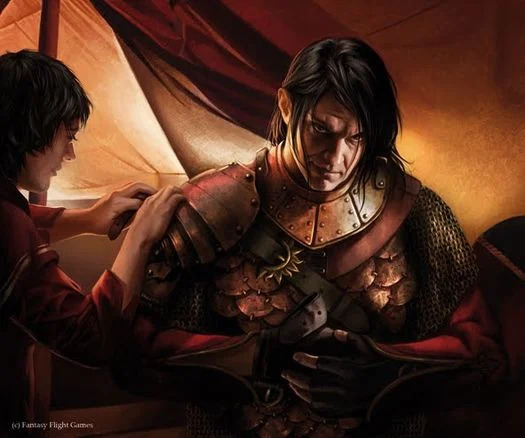
🎨 Credit: Magali Villeneuve
And his description:
has the features of a salty Dornishman [more below in section C, but: "These Dornishmen are lithe and dark, with smooth olive skin and long black hair, having been most strongly influenced by the Rhoynar"]. He is a tall, slender, graceful, and fit man, and has a lined and saturnine face with thin eyebrows, black "viper" eyes and a sharp nose. His hair is lustrous and black, with only a few silver streaks, and recedes from his brow in a widow's peak.
Arianne looks something like this in one source:
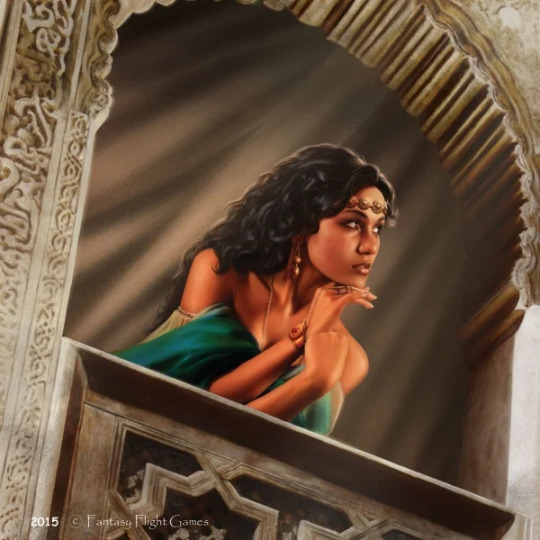
🎨: tiziano baracchi
Darker than "olive" Her description:
is buxom and beautiful, with olive skin, large dark eyes and long, thick black hair that falls in ringlets to the middle of her back. She has full lips, a husky voice, and round ripe breasts with huge dark nipples. Favoring her mother Mellario, Arianne is short, standing at five foot two.
Mellario was from the Essosi "Free City" city of Norvos but their skin color is not really described.
Oberyn's daughters all have different complexions and mothers of different origins, Westerosi and Essosi (all descriptions from the official wiki):
Obara -- "big-boned woman near to thirty, long-legged, with close-set eyes and with the same rat-brown hair of her mother which she sometimes ties in a knot. She strides quickly and angrily. Obara has callused hands and can have a mannish look." -- mother: unnamed Oldtown prostitute
Nymeria -- "slim and slender as a willow, with straight black hair worn in a long braid which pulls back from a widow's peak. She has dark eyes which are large and lustrous. Her full lips are wine red and curve in a silken smile, and she has high cheekbones. Areo Hotah describes Nym as having pale white skin in A Feast for Crows but mentions her olive skin in A Dance with Dragons." -- unnamed noble Volantene, specifically of the "Old Blood" - Volantis, another Free City in Essos
Tyene -- "is fair, with golden hair and deep blue eyes. Dimples bloom in her cheeks, and she has a gentle, sweet voice" -- mother: a septa from the Reach
Sarella -- "light brown skin" -- mother: the Summer Islander captain of The Feathered Kissed ship
Elia -- black hair/"her black braid flying behind her" (The Winds of Winter, Arianne I) -- mother: Ellaria Sand
Obella, Dorea, and Loreza -- no description as of Nov 5, 2023 -- mother: Ellaria Sand
Ellaria Sand is supposed to look like this:

🎨: amok
Her description:
Although not accounted as a beautiful woman, Ellaria is regarded as attractive and eye-catching, with an exotic, sensuous flair. She has black hair.
AND
"black-haired paramour" & "She is not truly beautiful, she [Sansa] thought, but something about her draws the eye."
(A Storm of Swords; Sansa IV)
And Doran Martell (currently reigning as the Prince of Dorne) has no canonical physical description aside from "His body is soft and shapeless, and the gout has swollen and reddened the joints of his knees, toes, and hands." However, since he is Oberyn's brother we can assume that he most likely has similar "salty Dornish" coloring.
C)
The anon of the first linked post all the way up above: "GRRM himself has said that the closest equivalent of Dorne to the real world is the Moorish influences of Spain, and mentions PALESTINE and Wales as being two other influences. Literally his own words. Even in Game of Thrones, they filmed the Water Garden scenes in the Alcazar of Seville, a beautiful Moorish castle in Spain. That castle was literally built by Muslims and incorporates verses from the Quran and countless traditional Arabic and Islamic architectural elements".
You: "there is absolutely no characteristic of Palestinian culture in Dorne or the Martells. Their stans only use racial stereotypes about us & orientalist characterization to justify it and prove that the Dornish are “POC” in order to make them seem oppressed, and are pushing even more racism and orientalism towards MENA populations" AND "North African, West Asian, and South Asian countries are lump together as one monolithic “brown people” entity." AND "They keep using the screenshot of GRRM listing Palestine as one of his inspiration for Dorne to justify their headcanons, so why do they keep insisting on using Bollywood movies, Indian actors, Indian monuments, saris, etc ?? The only common points between the Alcazar of Seville/Alhambra and the Taj Mahal are the Islamic architecture and the engraving of Quranic verses."
1.
If we are talking about race vs ethnicity & the rise of racism from religious or ethnic differences and a desire for colonial domination...
Dornish people mainly live in their own principality or a kind of state controlled by a "prince" or "princess" that is actually unlike the Rhoynar cities because there were multiple "city-states" under several Rhoynar princes and princesses who, while sharing a language, also likely had different laws and sub-styles of the dress and think of themselves as culturally/ethnically different from each other.
Thus in terms of Dornish people being oppressed or experiencing racial oppression alone (bc with race comes the oppression you cannot separate these twon phenomena since race as a constuct was specifically created for several human right violations and power hierarchies), we cannot compare Dornish people nor the Dornish state to Palestinian refugees and Palestinians living under an apartheid. They are not the same, they are not living under the same conditions of racial or ethnic terror. And yes, a lot of Palestinian people out of this region of the Middle East draw a large part of their Palestinian identity from their memories and terms with the Nakba and the effects of said event that exist today and have been for more than 50 years. What I'd say is similar is that many Dornish may also draw some of their identity from their continued resistance to conquest...but the Dornish are not resisting ethnic cleansing, genocide, or racial extinction. The first Targaryen attempts at conquest were decidedly non-ethnic-cleansing so much as just your average kind of "conquest" that Andal, nonDornish Westerosi have performed against each other before the Daenys and her father ever settled at Dragonstone. Yes, Westerosi can be xenophobic towards Dornishmen but that includes the "stone", fair-skinned Dornishmen as we see from the continuous marcher vs Dornish conflicts over land & grudges/vendettas over past conflicts/deaths.
What are some traits of Palestinians or Palestinian culture that another anon was trying to say the Dornish currently have?
"Game of Thrones"--"filmed the Water Garden scenes in the Alcazar of Seville, a beautiful Moorish"
"the Quran and countless traditional Arabic and Islamic architectural elements"
"Moorish", as Medieval and early-mod period EUs used, referred to Muslim Arab-speakers. Aside from North Africans, Arabs, and Amazigh did include Muslim Europeans, because Islam itself was the defining basis for their difference from those Christian Europeans and the regions where people who adopted Islam or Islamic states dominated where those N.Africans, Arabs, and Amazigh lived. In a medieval context, DOUBLY SO.
Once again, Dorne does not worship any Rhoynish god & their official religion is decidedly of the Faith of the Seven (aside from those of the Greenblood, but these are not a large part, a dominant, nor very influential part of the Dornish population).
Nowhere did GRRM say that the Welsh inspiration only applied to the stony Dornish. Why do people think this? Perhaps because these are the ones closest to the Marches and thus fighting often with Reach/Stormland marchers, they'd be the most Welsh/Irish-like. The Welsh/Irish/Scottish inspiration, however, is the fight for separation from a conquering centralizing entity--societal/governmental separation from the rest of Westeros--& having a separate identity from that almost like Northmen seeing themselves as different culturally and ethnically from "southorn" Andal people and vice versa bc of their different customs regarding the allowed genders to rule that come from Rhoynar customs.
While there will be Rhoynish elements to fashion, architecture, metalworking, and inflection of the Common Tongue (accent)...it does not stop the Dornish from, again:
recognizing that their state language is the Common Tongue [the Red Princes & some of their descendants of the Martells tried to eradicate the use of the Rhoynish language from the Red Princes] even though many of the Dornish's accents are very influenced by the Rhoynar to the current day
worshipping the Seven and not Rhoynish gods
having some elements of Andal fashion and architecture along with Andal ones, even if the "stony" Dornish have more Andal influence in dress, etc. [think of Spain and its Arab or Islamic architecture...Spain is a European country]
having a class system similar to Andal-FM Westeros: aristocracy, or the "ruling class" vs everyone else [less about the culture here, more about hierarchy structure which is not the same as a culture]
No matter how far down south or into the desert we go. Of course, dress will change in different Dornish regions' climates but also by class and/or wealth.
2.
And this is said screenshot of GRRM talking about the influences that made Dorne what it is ("So Spake Martin", 2000):

"flavor given the culture [previous Andal Dorne preNymeria] by the great Rhoynar influx"
"South of the wall a hot, dry country more like Spain or Palestine [not just Palestine, and this was referring to climate in the first place, not culture]"
"Moorish influence [not dominant power or overlord] in parts of Spain [not an African, Asian, etc. region, again, emphasis on it being like Spain with an "outsider" "influence"]"
"Dorne is Wales mixed with Spain and Palestine with some entirely imaginary influences mixed in" [emphasis on Dorne being claimed as an amalgamation with just one PoC real-world state with PoC populations]
People need to see GRRM's "mixing and matching", and no "non-for-one transplants" regarding PoC influences. Westeros, though obviously an England/Anglo-Saxon "transplant", is still not exactly historically like England in that Dorne is similar but not equal to Wales or Spain or Turkey/Palestine yet not itself equal to a Caliphate due to religion and language.
However, aside from the Dornish not really even being a part of a racialized state under a dominant power racialized as superior, this is what GRRM says about the Dornish and Martells (his blog, 2013):

This is about what GRRM said in terms of JUST physical appearance -> "As for the Dornishmen, well, though by and large I reject one to one analogies, I've always pictured the "salty Dornish" as being more Mediterranean than African in appearance; Greek, Spanish, Italian, Portugese, etc. Dark hair and eyes, olive skin. Pedro Pascal is Chilean. (Check out Amok's version of the Red Viper, that's how I saw him. Or Magali Villenueve's beautiful and sexy portrait of Princess Arianne)."
And this was one of the responses:

Most relevant piece bc it mirrors the anon's definitions of race: "If Alessandro de'Medici was the Duke of Florence, why not a brown man as the Prince of Dorne? Even now, with your description of Dorne as "Mediterranean," I immediately think of the vastness of the region, which saw so much North African and Middle Eastern influence."
This entire exchange on GRRM's website reveals that originally the Martells/most Dornish were inspired by EU Mediterranean people, like the Portuguese or Spaniards, Greeks and Italians.
a.
While it's certainly possible bc of the proximity of geographical locations within the Mediterranean regions and the population makeup of various Italian states including "Moor" and darker-skinned folks, we don't know for absolutely certain if Alessandro de Medici truly had a slave-servant mother or otherwise an Arab/African mother--he was one man whom many in those upper circles wanted gone for their own rise to power.
Unfortunately, while there shouldn't be anything wrong with being of a woman with a different ethnicity or religion, claiming that he was from a "Moor" mother would be a way for other people to try to diminish his reputation and likeness-peerage with those in court as Alicent and the greens trying to claim Rhaenyra was unfaithful to Laenor and that her kids with him are actually bastards to ruin her reputation. It wouldn't be about the "truth" so much as swaying public opinion with certain details of appearance. A political strategy.
At the same time, who knows, perhaps they used the fact of him looking darker than a lot of EUs around them...but the EUs themselves have married N.Africans and also came in several "shades"...so yeah.
If we are only talking Watsoniansly/in-world/in-text vs modern ethnic (not racial) identities, your mother being a "Moor" or Muslim did not make you yourself a Muslim, Moor, or racially "Black" or Arab, and "biracial"/"mixed race"--as a racial term or category of Blackness or whiteness--wasn't a thing for these Italians.
b.
One man/a few people in higher circles or in power doesn't make the entire family or state PoC when most of them appear pale, speak a specific Italian dialect, AND live under European customs forever after and before.
His presence did not recreate the entire Medici or anyone descended from them into Africans/Arabs ethnically nor racially. "Racially", he would have been seen as "more" "noble Italian Christian" than anything, even with some using his skin to liken him to the socially suspected, racialized "Moors". And just because there were absolutely NA. and M.E. influences in many non-EU and EU music, literature, architecture, etc., doesn't make every Mediterranean person PoC. (We find out that the idea of courtly love partially was influenced by an Islamic mystical conception of love itself as being "a delightful disease, as demanding of faithful service" [coming from Crusade contact]. It doesn't suddenly mean that "Italy" [one of the first regions to pass down such things through Petrarch] became/was/is a PoC region. Still doesn't make Italians PoC.)
RACE - Mediterranean/Italian/Spaniard/Portuguese/Southern Europeans have BOTH been racialized as "lesser" whites in early modern period European AND have the closest proximity to the "best" whiteness that always becomes THE definition of "white" under pre-WWII phrenology and eugenic scientific racism. "Best" becomes "true", never leaving its own hierarchy but always able to retreat back into its own "absolute naturality" to justify that created hierarchy. These two things came hand in hand and justified each other because both sought to "prove" that "biological and behavioral characteristics were fixed and unchangeable, and placed individuals, populations and nations inside of that hierarchy" through skull measurements...which itself comes from that medieval idea of one's "nobility" or lack thereof being indicative in appearance.
As I said above, even today, some white people of Protestant-N.European backgrounds sometimes look at Italians/Italian-descent people through their stereotypes of being "hotblooded", and hypersexual "white" people. This is most definitely an element of racialization. These "other" whites are those descended from the NorthWestern regions of Europe (England, France, Germany, and Scandinavia/Nordic people).
c. HOWEVER!!!!! [now we're talking TV adaptations]
The user in the pics above who wished for more PoC representation in the TV and book series through the Martells makes a good point that "Mediterranean" doesn't have to be limited to the European Med regions and peoples. Because N.African, ME, etc. peoples (those not racially classified as "white") are also directly connected to the Mediterranean Sea: Turkey, Egypt, Palestine, Libya, Algeria, etc...it's weird how race makes us consider these people not Mediterranean, but that's race for you, it denies culture and ethnicity for the sake of "white" supremacy
GRRM does conflate the general Mediterranean with EU Med, and that's because the racial category "Mediterranean" defines "Mediterranean" as "white people from Spain, Italy, etc"
While there weren't "black", "PoC", "brown" racial categorizations in any Arthurian legends nor the societies that these came from, there were racializations (as in descriptions and sense of the person that made them different by look by some "degree" even if not toally by "kind") of characters that were told to be of different/non-EU origins.
they were expressing the racial problems with GRRM's original intent for the Martells and some Dornish to be imagined as those who'd be categorized as PoC or brown in the modern world, telling us that there is room for PoC in-world leaders and nobles as there were in Arthurian legends and other medieval romances
They were right to point out the overall, serious difference in how most PoC-confirmed or imagined or similar people were more "supporting characters" to specific "white" characters and that there was a transmedia need for more diversity where the PoC-acted/played characters in adaptations since the original works AND adaptations are made for racialized audiences of the modern world.
d.
Like with Charlotte Bronte's Jane Eyre--where Rochester's first, "mad" wife, Jamaica-born, Creole-heritage Bertha Mason, aka Bertha Antoinetta Rochester--we see a lot of debate over characters' racial identities between white and PoC readers in multiple EU pieces of literature. This is a thing descended from that academic conflict that is sociopolitically motivated.
The documented hot refusal from many white historians and "lay" white readers to even contemplate the possibilities of a PoC-featured-character (positively or not) under certain circumstances comes from the enduring acceptance and expectation that most mainstream media will have whiteness at the center and default of the story. That the media is created and will be created and should be created for white audiences. which is exactly what we should be breaking.
3.
So, I believe that the reason we have people saying the Martells are PoCs is because they saw the definite potential of modern racialization from the precursors of true racial categories happening in ASoIaF that can become like those in real modern societies; they wanted to see themselves or their experiences in the fiction they engage with, just like that user above. Just like that commentator. So they use South East Asian clothes and other things to fan cast/re-cast/reimagine even after what GRRM has made bc before then they have already built that picture for years since they read the main series and before the show aired.
When English/NW Europeans and pre-1800s writers say things like "swarthy" or "tall, dark, and handsome", they were not usually saying this person was as dark as a Western African but they may sometimes use racial/color ideology to characterize a EU white person as "too passionate", "blustering", "angry", and "lacking enough proper restraint". GRRM is the same, as he tells us in the picture above from his blog!
And since we can't always detect a person's race or lineage just by looking at them, it also still means that they may have African or Middle Eastern ancestry. Then we got to ask ourselves when and where do some of our (mostly the U.S. I refer to, but other countries' racial categories are still very different) definitions of race need to overshadow the text/past racial categorizations and racializations? It's even stranger when you realize that even caring about something like this comes from a very specific history series of particular events of people performing racialization.
But even though the now-Dornish are a people who have been forever changed by pre-Rhoynar Dornish men's intermarriages with Rhoynar women, their kids (and not the nonDornish Westerosi) were the ones to determine what Dorne would look like.
Though they seem to match the definition of a "mixed race" and therefore are equal to persons racialized as "PoC" today, in many societies like the U.S. (one-drop and grandfather clause), that simply doesn't exist for Dorne because there was no nonDornish oppressive power that defined legal racial definitions that affected their infrastructure or made them second-class citizens for them to then develop their own ethnicity like Black people in the U.S, which is its own race-ethnicity developed from legal and economic atrocities and racialization.
Most of the oppression common-born Dornish face is from Dornish aristocracy! Class-based rather than race or religion-based.
Yeah, there's a possibility that some people felt a sort of having two different identities as the kids and even grandkids of Nymeria's women and the pre-Rhoynar Dornish men, but without that element of another group enforcing a new racialization to further divide the Dornish (as Daeron I foreshadows or clues us in?!) all there is that shared history and Martell overlordship, and the Martells are one of those with the most Rhoynish/not-Andal-FM influence. Of course, most of Dorne will follow suit. There are no laws in place to determine who is "PoC", "Coloured", or "white" or any ASoIaF-fantasy version. They have a past/centuries-old and successful intermarrying between (mainly male) Martells and Nymeria's (mostly female) people WHILE having the same language and religion as the rest of Westeros, as well as other customs.
With the way GRRM made them, they are both "white" and not "white" (according to NorthWestern Europeans of the 1800s onwards) because "whiteness" as an actual race is not a thing in Westeros. And for the sake of readers looking for people to claim to have PoCness, whiteness itself has undergone several definitions according to the immediate political needs of those holding the higher positions of power or influence in the state or groups within states seeking political privileges from being racialized by that dominant society's legal and social systems.
This means they can be as "dark" as GoT Oberyn and even have what some modern people see as Arabic physical features (which kinda makes little sense bc Arabs share a lot of features with some "Med" Europeans, especially Turkish ones and Palestinian Arabs themselves have a spectrum of color, face shape, etc.) but we also see how they can be quite diverse in the canon with paler "stony" (not a true ethnicity, this is a racial category that Dornsih people do not see to acknowledge and therefore is not an ethnicity) people and Oberyn's paler daughter Tyene.
Refrain: The Summer Islanders, though, ARE DEFINITELY the "Black" people of Westeros. As GRRM says in the pic I showed.
D)
Again, "race" existed AND continues to exist to differentiate the "inferior" people from the "superior" "white" race of paler-skinned, loose/flat-haired, North-Western-then-South European peoples whose ancestors they could trace or identify with most were Christians. Whether in Brazil, all EU countries, the U.S., etc. Yes, European people/countires can be and continue to be extremely discriminatory and racist, esp against Africans and Romans. Individually and legally.
In the modern world, race is categorized differently across today's world, as evidenced by what "black" means in Brazil vs the U.S.; the South African Coloured group vs "black" vs "white" vs "Indian" (apartheid race categories, and "Coloured" still is relevant and a sort of racial category in S.Africa today); "mestizos" vs "peninsulares" vs "mulattos" of various colonizations-slavery era-to-today S.American, Mesoamerican, Caribbean countries. All because "race" is a socially constructed category, made by culturally-ethnically external persons of power over another group. Ethnicity, however, is and has always been a factually independent phenomenon.
"PoCs" as a term in itself a racial term that means "anyone who is not pale skinned AND of long, consistently 'uninterrupted'/'impure'/ European descent". It is not an ethnic term or a name for an ethnic group.
Ethnicities are social groupings purely based on shared cultural heritage, descent (from specific other ethnicities), culture, religion, and/or language.
In this way, there are 3 main ethnicities in the whole of "Westeros", which are those of FM, Andal, and Rhoynish descent and we could even argue that there may be more unknown smaller groups. And none of these are racial groups! Two of the three also share the exact same religion and language and most customs barring sexuality and primogeniture (except those of the Greenblood, who still speak Rhoynish): those of Andal and those of Rhoynish descent. First Men-descent peoples of the North worship the old gods of pre-human Westeros.
Intermarriages between certain ethnic groups were not systematically and socially outlawed or discouraged to maintain the visible and legal distinctions between racialized groups in either Dorne nor not-Dorne. No ethnic or religious groups are banned from taking certain jobs or entering guilds; no particular groups were banned from living in certain areas or even traveling and using certain items and ways of travel. (We're talking about the humans, not the TWStSotE or the giants, bc we are doing ethnic groups, not totally different species.)
How do groups get racialized and prepped for legalized racialization? Governments--monarchies and aristocracies, here--attempting to better organize their control over populations and consolidate power after past and very recent conflicts with "foreigner-conquerors" like the Muslim conquest of Hispania by the Umayyad Caliphate, to whom the anon before referred (Limpieza de sangre).
Why are they "foreign", besides coming from a literally other region and culture? Medieval people's primary identity marker besides class was religion, and Muslims were considered actual enemies of Christian societies in Europe. People saw religion as the means by which people were "inherently" different:
Especially in a period like the Middle Ages, when religion meant membership of a community much more than adherence to a set of principles or beliefs, there was a sense in which one was born a Christian, a Muslim, or a Jew, just as one was born English or Persian.
("Medieval and Modern Concepts of Race and Ethnicity"--Robert Bartlett)
This is also why in medieval literature, Jewish people were referred to as "black" and "dark-skinned" pseudo-metaphorically, as Christians had the "true" faith and therefore were spiritually "bright" or closer to God's "light". And humoral theory, with Jewish people being conceived of as a people with a more melancholic constitution (black bile = melancholy -> night, evil, malice, envy):
The Isagogue, an Arabic introduction to Galenic medicine translated into Latin in the eleventh century, similarly explains that dark skin identifies black bile as the body's ruling humor. (8) The linking of black or dark skin with melancholy continues in European texts of the twelfth and thirteenth century. Short poems delineating humoral types circulate widely in the period; the "Melancholicus" is described as "envious and sad, greedy and close-fisted / not without deceit, fearful, and of mud color [lutei].
("The Jewish body in black and white in medieval and early modern England"--M. Lindsay Kaplan)
Thus Jewish people were named "black" for their nonChristian-ness and thereby untrustworthy or "grasping" natures.
Then there is the separate history of the idea that "nobility" (as in "bravery", "virtue", and overall "good and attractive 'quality'") could be seen outwardly and obviously through physical features that curiously never actually get a consistent list or picture until the 1200s-1300s (it's always been at least grey eyes and/or blonde hair). We have to remember that the ancient Greeks and Romans were used as the medieval Europeans' inspirations for medicine, morality, philosophy, beauty standards, etc., and they themselves did not give highly detailed portraits of what makes a person "beautiful" or even in just describing women in other than vague, noncomparable terms or singular traits: Athena had "grey-eyes" and that's it...Aphrodite's hair was "long", Briseais was "tall", Chiseas was "not tall", and Hera had "nice arms". Their main concern was what men looked like and if their bodies looked "strong".
It wasn't until poets and bards of the 1200-1300s began to make lists of more features that made women attractive that we get more detailed portraits of "good-looking" people and men vs women attractiveness. (For women, the "best" became to have small and high breasts, grey eyes, blonde hair, pale skin, white teeth, a mouth like a rosebud in size and shape, wider hips, a plump butt, and finally a round and pudgy belly. Basically a "pear-shaped" body). And this turned into the literary device of the "blazon", which the medieval poets (Petrarch popularized it) and later early-modern period poets, dramatists, and other writers, as PoetryFoundation says:
A literary blazon (or blason) catalogues the physical attributes of a subject, usually female. The device was made popular by Petrarch and used extensively by Elizabethan poets.
describing and making the body as a list of individual parts instead of its own whole thing, so that parts of the body can be compared to other things and thus give a certain characterization to the subject that way. The subject themselves becomes less themselves and more the perspective and "dream" of the writer/audience.
And "racial and racist stereotypes—even ostensibly positive ones (such as “Asians are good at math”)—by definition, conflate and confuse biology and culture" ("Were Medieval People Racist?").
Combined -> the setup(s) for early modern-to-current racializations.
E)
We do see some of this sort of attempt or precursor of solid racial categorization from the nonDornish towards Dornish people regardless of class: "salty", "sandy", "stony", and less known, those people who still speak Rhoynish and live by the Greenblood:
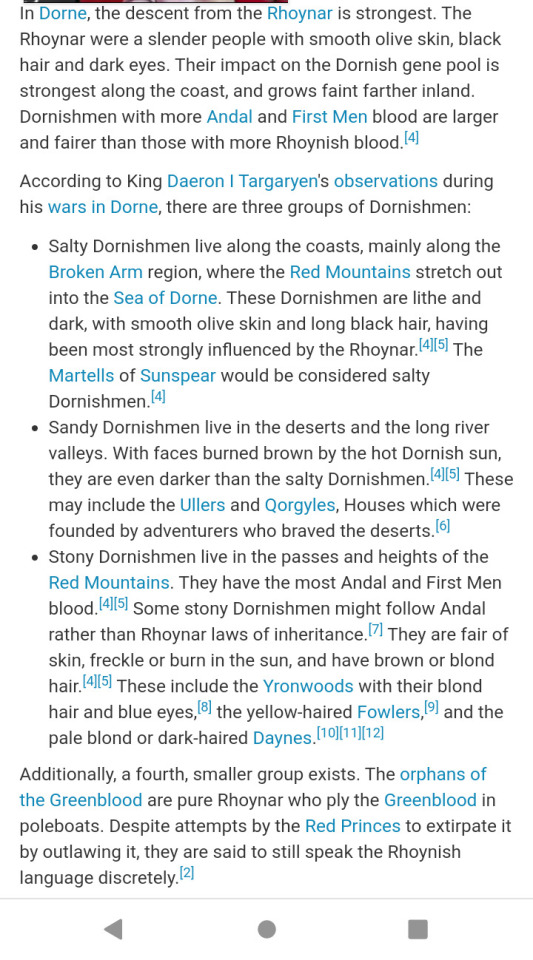
The "salty" vs "sandy" vs "stony" things are all exonymic proto-racial categorizations (like the term "Moor") that still don't present different real racial consequences among those Dornish.
Exonymic? Meaning that they are not categorizations made by the native people--noble or not.
It's not like Daeron I would have out-of-the-blue been able to create these categories without there already existing a socialized link between Rhoynish culture and "negative", not-patriarchal-enough nobility. Rhoynish influence/culture directly defines these categories. (But he didn't impose nor did an entire other group of people impose infrastructural change to Dornish society for the sake of their own created racial supremacy...ever.)
There are/were several battles and skirmishes between Stormlanders, Dornish, people of the Dornish Marches, and Reachmen Dornish. AWoIaF relates, "hot-bloodedness and sexual licentiousness, and are still viewed with some mistrust and rivalry by the people of the neighboring Dornish Marches and the Reach". Dorne's equal primogeniture (i.e., far less intense and critical misogyny) and freer sexuality are those things that are made more definitive of the Dornish's political difference and separation from the non-Dornish aristocrats at least at the time of Daeron II's court and marriage [zaldrizer-sovesi] AND "race" as a concept does not track equal to what we consider "race" and those racial experiences PoCs have in modern societies despite these definitions WHILE still indicating ethnic discrimination.
It's funny, because rather than the Jewish "melancholia" described above, the Dornish, by their nonDornish association, would be considered a "sanguine-choleric" people for their "hotbloodeness" and "sexual licentiousness" that really comes from:
a long history of skirmishes with other Andal peoples, then the first 3 Targs and still surviving as their own state, then those eternal ones for revenge and small pieces of resources between houses along the borders of Dorne to the north...leading to the fierce Dornish independent identity
comparatively freer sexualities and fewer sexual restrictions on gender roles (men and women, as men having sex with other men is very taboo and emasculating in the ND, "100%" Andal-FM culture)
and not treating women leaders as an anathema (equal primogeniture)
Yes, there is no racial Dornish diaspora like there is a Jewish or Black diaspora ("the dispersion or spread of a people from their original homeland" usually due to wars, violence, displacement, etc.). With Dorne and Dornish people being politically and culturally independent--both in idea and practically since before Daeron II's marriage to Myriah Martell--there were definitely Dornish people moving in and out of nonDornish Westeros and some would inevitably live in ND Westeros, these people are migrants-dual-subjects of a state that is still in all the ways it matters, independent. unlike Black people in the U.S. or Coloureds in S. Africa, whose governments historically and currently gave/enforced these categories developed from European-to-settler/colonist racialization. And unlike anti-Semitic/Islamophobic laws & anti-blackness and other real-world measures, there is no evidence of any oppressive laws or daily discrimination against Dornish communities (I'll say the Sylvenna Sand of Dance fame is an indication of Westerosi patriarchy looking at Dornish less-intense patriarchy as a lesser-"dangerous" identity maker).
Their "racial?" identities also do (yet, if it will go exactly like real life) not have the oppressive or racial context that enables people to argue that Rhaegar left Elia, didn't love her, or valued her and her position as his wife because he felt racially superior to her--esp with how we have no literary (symbols, metaphors, parallels in-text) nor direct evidence of Rhaegar seeing Elia through a racial bias as his father does with Rhaenys their daughter when she was presented (which is what this entire thing came from, as Elia/Martells stans claimed and what drives that argument in this post/reblog HERE).
It is that the Dornish will be considered the lesser "race" if there ever came a time when they were ever truly conquered and imperialized by ND peoples from Westeros. For now, it is far more accurate to say that there is ethnic bias against the Dornish or the Martells that could slide into racism.
GRRM created a world and fantasy series that is trying to simulate a medieval racialization of people WHILE also inevitably showing the roots of modern civilization, which are two different forms of racialization that are nevertheless connected. In other words, GRRM hasn't successfully made 1-1 analogs concerning race.
But does "origin"="being"? How and why?
Therefore, we do see a race or race existing in Westerosi ideologies, but it is BOTH not as prominent as how they regard how women should be treated AND comparatively more fluid to modern-day race and even changeable.
Refrain: The Summer Islanders, though, ARE DEFINITELY the "Black" people of Westeros. As GRRM says in the pic I showed. I have to repeat this because I can see people trying to take advantage of it.
In All...
A people of the first few "mixed" Rhoynar and "100%" Andal Dornish children from intermarriages that are no longer just "mixed" individuals. To claim that they are anything else is to begin the process of racialization, as such a phenomenon (intermarriages between previously separated ethnic groups to become a new distinct one) actually happens more often than not, and to make it unique to just the Dornish is to Other it for racial categorization, as NonDornish aristocrats probably would do. Fans refer to the state of "Westeros" as a "nation", it was not a nation but a territory of several states and smaller fiefs owned by nobles who collected taxes from local peasantry and probably gave a portion of that to the King/Monarch, keeping the "King's peace" (feudalism). The reason why there is a divide between "NonDornish" and Dornish people is the measure of how much Andal vs. Rhoynish culture makes the infrastructures and political practices in the respective regions, and there just so happens to be much more Andal-influenced regions and more people than Rhoynish-influenced without Andal culture becoming either true or "official" overlords over Dornish people in any unique or oppressive way different from how the Monarch is the "overlord" over a Stark, Karstark, Tarly, Hightower, Lannister, etc.
I think anon from that ask is saying that GRRM intended for the (arbitrary number) 80% of Dorne (therefore "Dorne") to be PoC and thereby make it a PoC state/people through choosing to mix several ME, SE, and N. African cultures's properties into a new fictional "Rhoynar" people. To them, this mix-match defines the Dornish as PoC because they see the Dornish people as being a "mixed-race" group of individuals like biracial children of modern interracial couples, and they continue to be biracial exactly as conceived until the current time of ASoIaF.
However, the modern "mixed-race" depends on the already existing races created by the world one lives in and only can be active and politically real races within a society with such definitions and dynamics of race built into its legal & education systems.
Still, though PoCs are historically and currently oppressed groups (aside from EU Jews, who were/are white and were continually oppressed) in places where European imperialism and colonialism reshaped previous societies, it's not correct nor wise to say that all or most PoCs draw their very being/humanity from discriminatory violence alone instead of the racialization oppressive groups performed because identity itself is not as simple or absolute and enduring as race and oppressive regimes try/tried to make. Or their ethnicity, like Black Americans. It's just that:
racial identity is political identity, not inherent or made "true" by those oppressive forces, that is exactly what those oppressors want (proving "might" = "right")
Elia would never have experienced anything equal to even what a richer PoC person does in the U.S. in terms of race
the Dornish are not PoCs!
Refrain: The Summer Islanders, though, ARE DEFINITELY the "Black" people of Westeros. As GRRM says in the pic I showed.
#asoiaf asks to me#asoiaf race#dorne#asoiaf ethnicities#elia martell#the martells#self correction#dornish ethnicities
16 notes
·
View notes
Text
Madrid Week 3: Flashbacks
Hola a todxs! It’s Niko back with week 3 of studying abroad in Madrid. Time is STILL passing by really fast and slow at the same time, so I'll talk about it again — I’ve been here less than a month and it’s felt like half a year, but the days go by quickly. I don’t think that will stop anytime soon, but I’m here for it. More perceived time = more life lived, and I hope that my weeks don't start blending together anytime soon.
As promised in week 2, I wanted to spend this blog talking about my trip to Granada last weekend. Granada is a small Spanish town in the southern region of Spain called Andalucía. It’s got a population of around 230,000 people — nearly the exact same as my hometown of Arlington, VA, which is a suburb outside of Washington, DC. However, in place of tree lined residential neighborhoods and modern office buildings, Granada is filled with narrow cobblestone streets bordered by low, densely packed buildings and intensely intricate churches/palaces built hundreds of years ago.

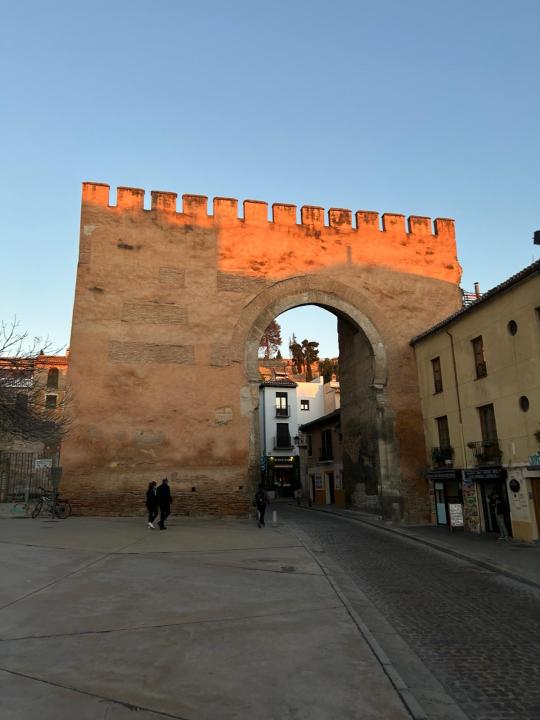

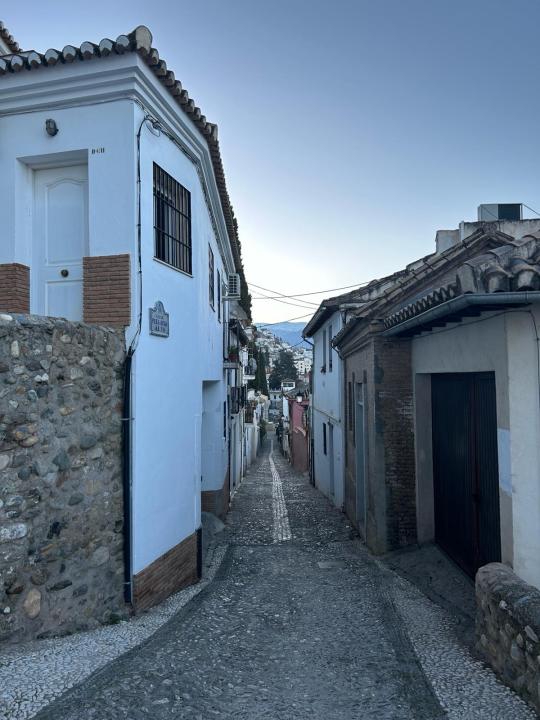
That palace — La Alhambra — is the largest tourist attraction in Granada, and was one of the main reasons I wanted to visit it (also, a big shout out to Emma for hosting me, a friend of mine from high school doing her semester in Granada!!). It’s a massive Moorish palace on a hill that overlooks the entire city. The Moors, who were North African Muslims, conquered much of the Iberian Peninsula in the 8th century. La Alhambra was slowly built between the years 1238 and 1358, during the reigns of Ibn al-Aḥmar and his successors.
With that said, my trip to Granada last weekend was not my first time seeing La Alhambra. As I mentioned briefly in week 0's blog, I took a trip to Spain with my 8th grade Spanish class for a week. That was 7 years ago. We hit most of the main touristic Spanish cities within that time, Granada included.
So, walking through the palace last weekend triggered a slow trickle of distant memories, fuzzy enough that I couldn’t remember details, but potent enough that I could remember how I felt. Some things had changed about the palace, many things stayed the same. I still felt the same sense of awe I did 7 years ago witnessing the incredible detail hand-carved into every surface, or seeing the palace perfectly reflected in a courtyard’s pool. The difference was that this time, I was exploring alone.
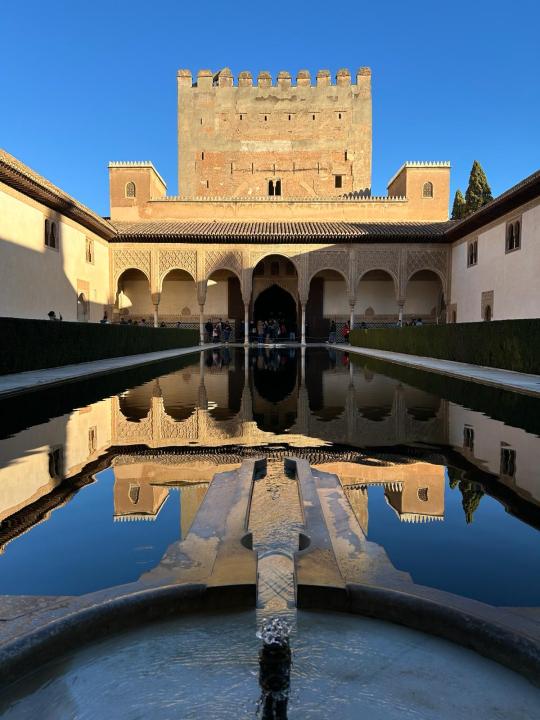
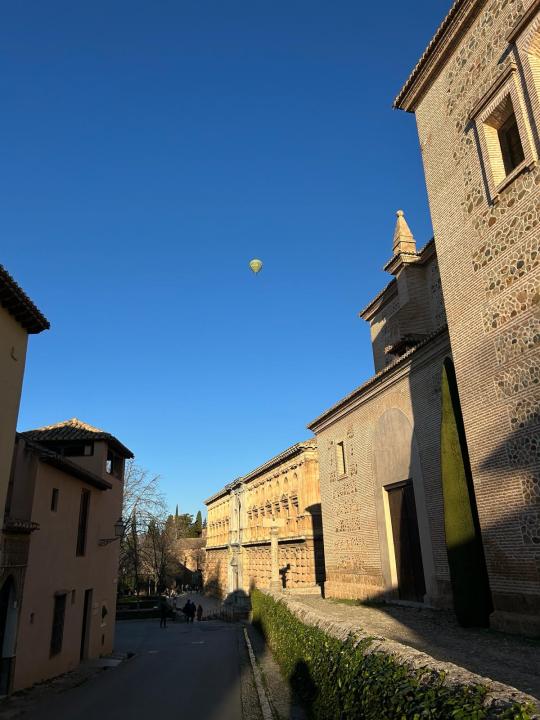
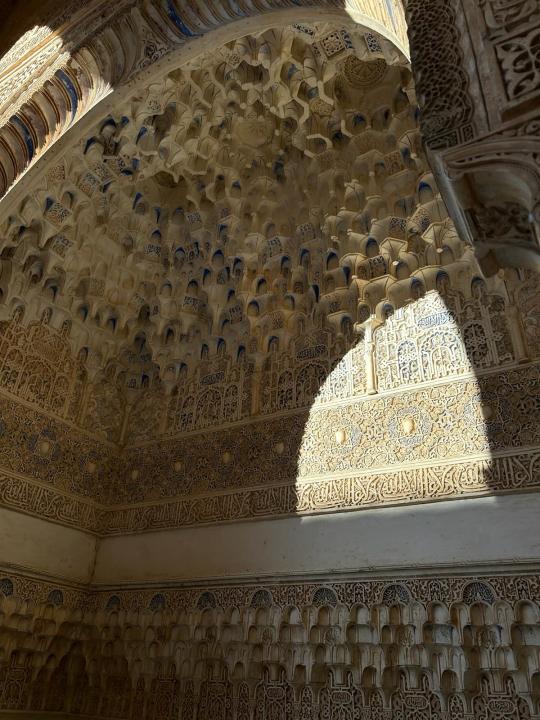
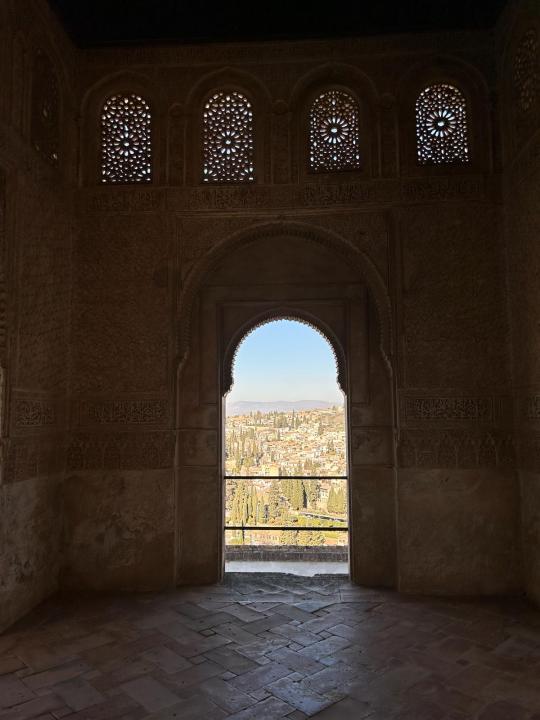
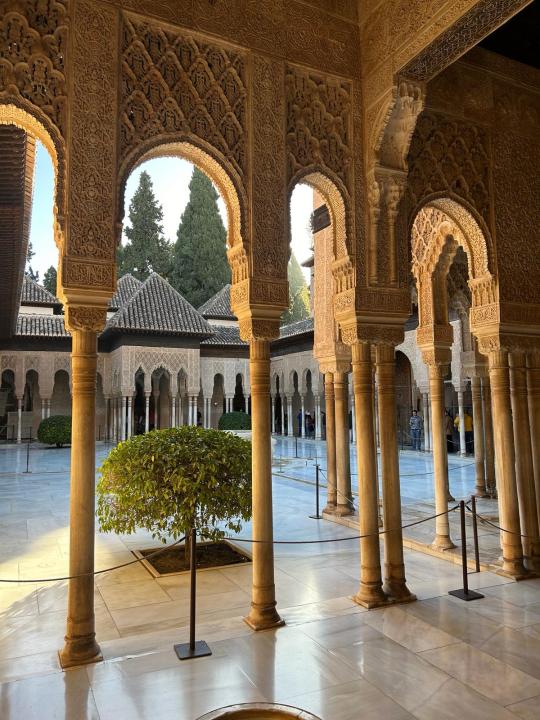
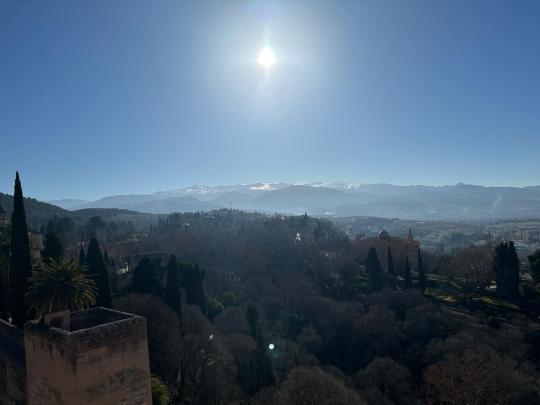
I think that during this trip, I really gained an appreciation — and curiosity — of solo travel. Although I was with my friend Emma much of the time, I felt a great deal of peace in exploring La Alhambra at my own pace. Without anyone else to turn to, I was forced to be present and attuned to my surroundings, and that enabled me to appreciate them that much more.
I think that part of that appreciation, however, was derived from the sense of independence and freedom I had existing alone in Granada. Going into college, being alone terrified me. I would step into the dining hall for lunch and wander through the common spaces, looking for a familiar face I could share a meal with. Now, I try my best to cherish the moments in which I can connect more to myself, whether that be during a meal, practicing a hobby, or exploring an ancient Moorish palace. That’s only something I've been able to move towards through consistent practice -- AKA, spending deliberate time alone. I hope to continue deepening that connection throughout this semester solo-exploring Spain and Europe, which I know is something I'll carry with me for the rest of my life.
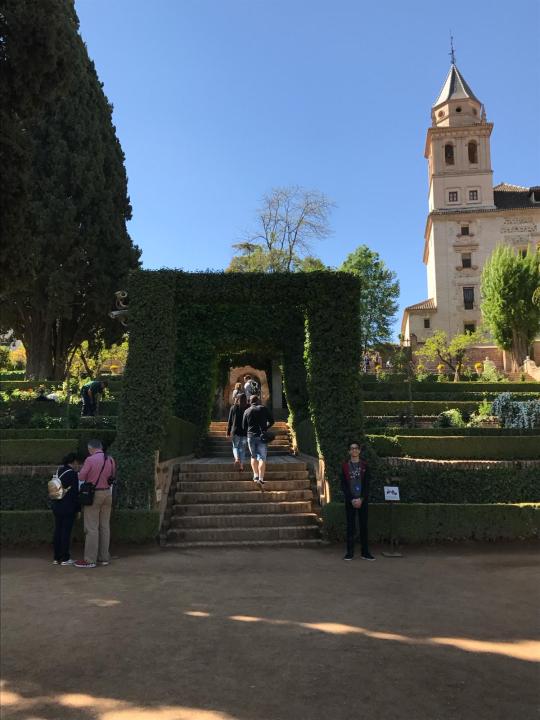
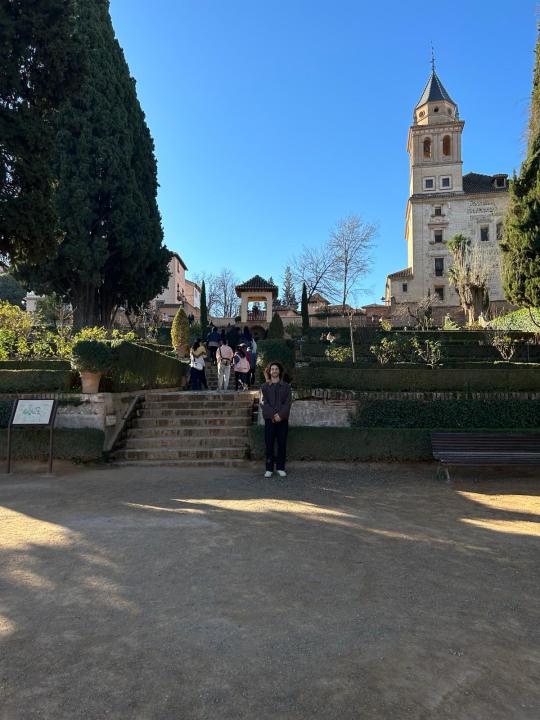
Aside from La Alhambra, Emma and I explored the city and its various landmarks (El Albaicin, a predominantly Muslim neighborhood, the Granada Cathedral, the Monastery of San Jeronimo, the Mirador de San Miguel Alto [and an epic sunset], and even a jazz-esque show with Spanish flair from a band at a local music club). More pictures below.

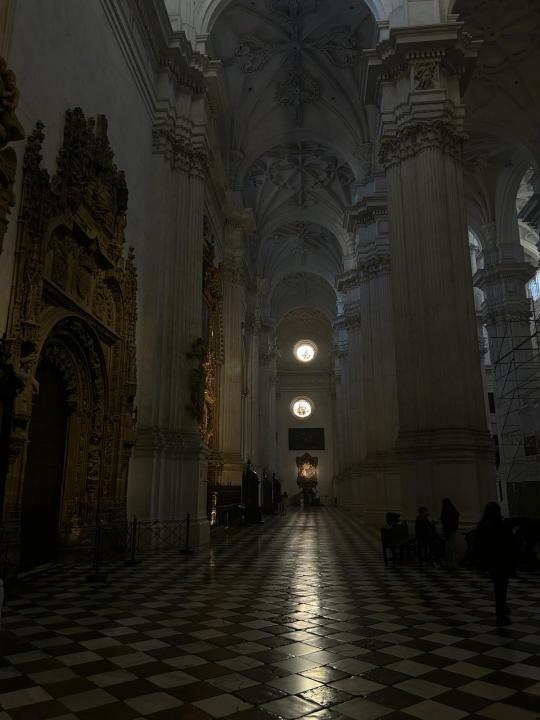
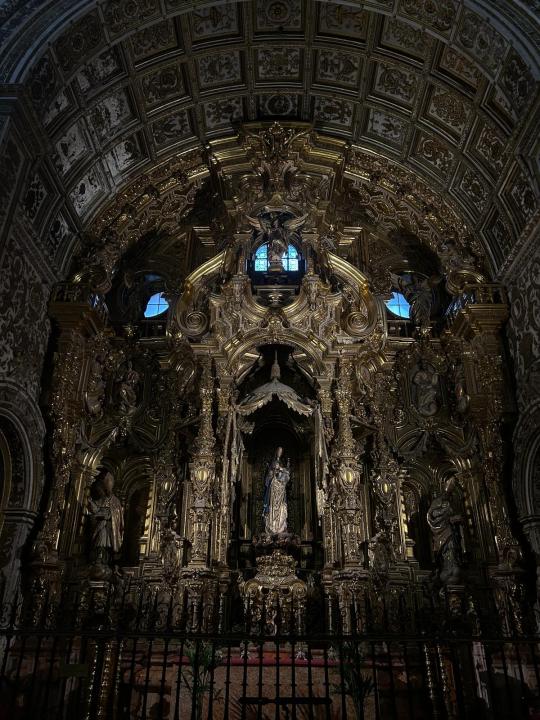

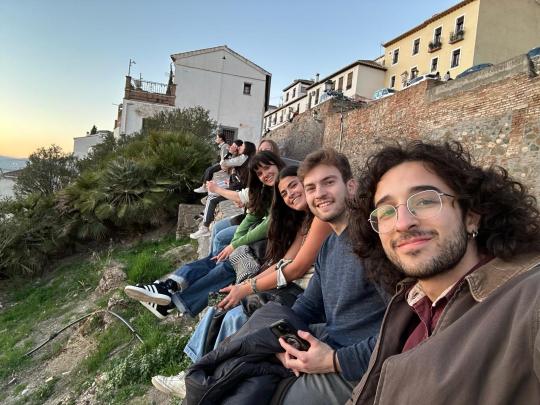
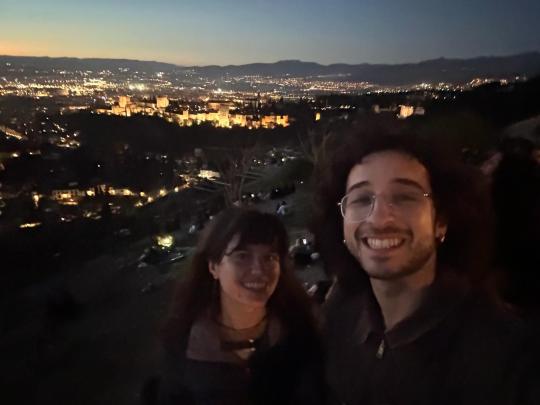

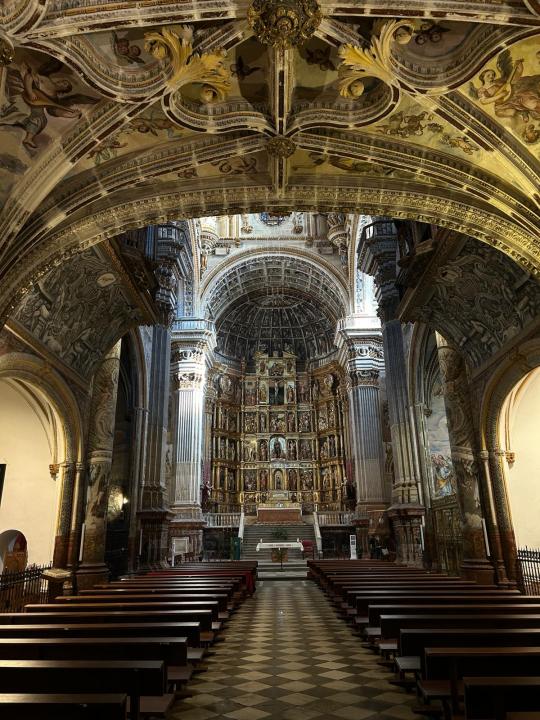
On the way back home, we stopped at a rest stop for the bus, and I couldn’t help but notice how familiar it seemed. It conjured up a nostalgic feeling that could have only come from my first trip in Spain — I realized we had stopped at the same station.
For old time’s sake, I bought a Kinder Egg Sorpresa. These things were a huge deal to me in 8th grade, as they are banned in the USA for being a ‘choking hazard’. Inside the chocolate exterior was a little plastic goat toy that will now serve as the centerpiece of our dining room table.
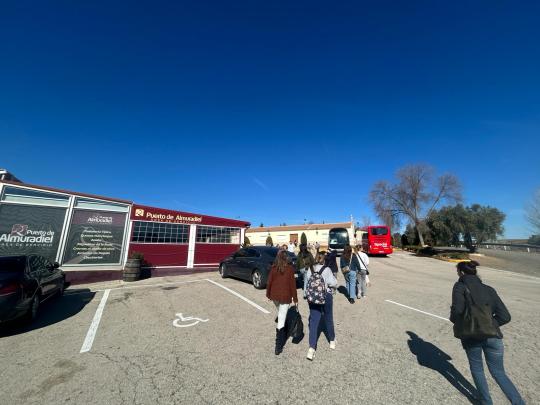
It’s funny to think how much of a different person I am from the 13 year old on vacation with his school friends and Spanish teachers. But it’s also comforting to know that all of these memories I carry with me explain the person I am today.
This week, I got a little more into school groove, took a rollerblading route, visited the Reina Sofia museum and went to see some amazing techno DJs over the weekend. Per usual, check out the photo captions for more info on the content this week :).
Hasta luego,
Niko Economos
Aerospace Engineering
Universidad Carlos III de Madrid
Madrid, Spain
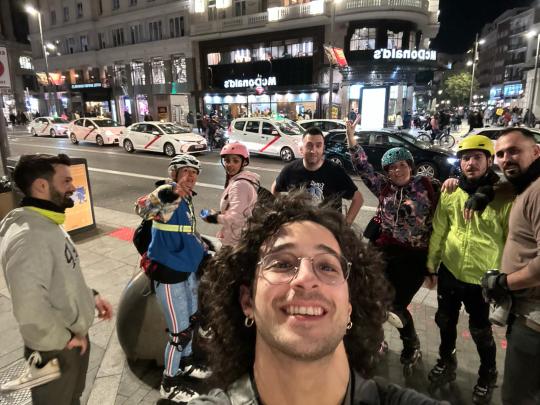
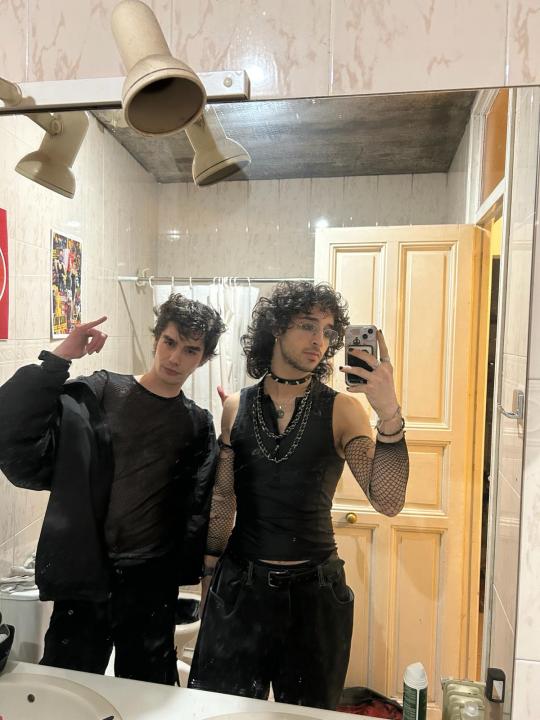

4 notes
·
View notes
Text

Here are some facts about the Moors in Europe: They ruled Spain and Portugal 754 years before the fall of the Mali Empire.
1. The Moors brought a wide variety of new fruits and vegetables to Europe.
The Moors brought many new fruits and vegetables to Spain and Europe that were considered exotic novelties at the time. These products included pomegranates, peaches, lemons, oranges, saffron, cotton, rice, silk, sugar cane, and a variety of other fruits and vegetables. Even though they are commonplace today, the Spanish at the time considered these objects to be almost alien. Several centuries later, they are still important components of Spanish food and production.
2. The Moors Developed Far More Rapidly Than Medieval Europe
The Arabs had an advanced civilization known for its architecture, science, mathematics, and exploration when they conquered the Iberian Peninsula. When the Moors arrived in Spain, they brought with them architectural innovations that astounded European stonemasons. The Alhambra, a fortress and palace complex in Granada, Spain, is one of the most stunning examples of Moorish architecture. Its construction started in 1238, and its grandeur and beauty far outstripped those of any comparable palace. It is still one of the palaces of the Islamic world that has been preserved the best today.
3. Chess Became Popular Across Europe Because of the Moors
Chess has been played for more than 1,500 years, but the Moors brought the game in its present form to Europe. The Moors brought chess to Spain after it had spread from India to the Arabic world. It spread through Europe's courts and society very quickly after it gained popularity. Chess was a well-liked game of strategy and endurance in medieval Spain. Chess was first mentioned in writing in Spain in the Catalan Testament in 1010 AD.
4. The Moors Took Their Hygiene Very Seriously.
A Moor, according to a catchphrase, "would rather go without bread than without soap." The Moors were known for their love of cleanliness. Due to their customs and the demands of their religion, the Moors valued cleanliness and often bathed; in the Moorish town of Cordoba, there were about 900 public baths. This made it possible to maintain proper hygiene at a time when plumbing and running water were still uncommon. Some sources also assert that the Moors introduced some kind of soap to Europe, ushering in a new era of hygiene.
5. The Moors Placed a High Value on Education
The Moors placed a high value on education and made sure that everyone in their realm had access to it. This was in stark contrast to medieval Europe, where education was only available to the richest nobles and clergy and where 90% of the populace was still illiterate. In fact, there have even been instances of European Kings who are illiterate. The Moors founded 17 prestigious universities in Spain, including ones in Cordoba, Malaga, Granada, Seville, Toledo, and Almeria.
6. Many Moorish Words Are Still Used Today in Spanish and English
The Moors introduced new ideas and words to Europe after they arrived, and these quickly assimilated into the common language. Up to 4,000 words in the Spanish language have Arabic roots, including algebra, checkmate, and influenza. Cipher, alcohol, chemistry, typhoon, orange, alkaline, cable, and nadir are additional examples.
7. The Moors Were Very Resourceful
The old Roman irrigation systems that the Moors discovered in Iberia had great potential, so they quickly adopted, improved, and revived them. This increased agricultural productivity and boosted the economy. Additionally, they were able to grow new crops they had brought, including figs, dates, apricots, lemons, and oranges. Thanks to the Moors' creative irrigation methods, Spain quickly rose to become one of Europe's top producers of crops.
8. The Moors brought significant Changes to Spanish Cuisine
For Europeans, spices were an uncommon commodity, and their cuisine was frequently regarded as bland. By bringing over hundreds of unusual spices, fresh recipes, and cutting-edge cooking techniques, the Moors altered that. We still eat a variety of wonderful dishes as a result of this culinary revolution. The spice markets of the Moors were renowned for their variety and provided options for chefs of all types. These medieval markets must have had the most amazing sights and smells.
#moors#mali#arabs#history#spain#portugal#europe#cuisine#food#spaintravel#lonely planet#architecture#good vibes#vibes#lifestyle#style#mood#aes#aesthetic#aesthetics
10 notes
·
View notes